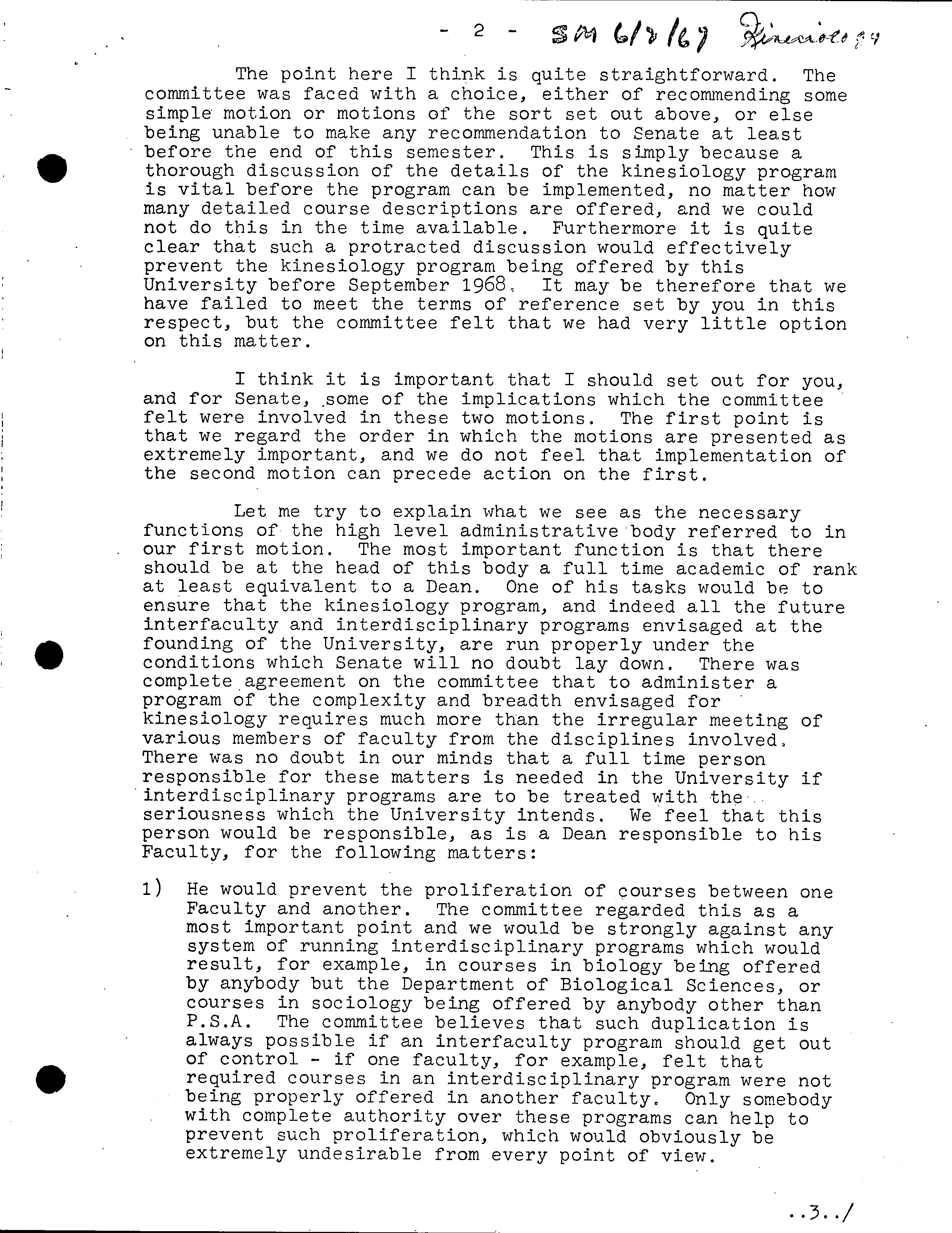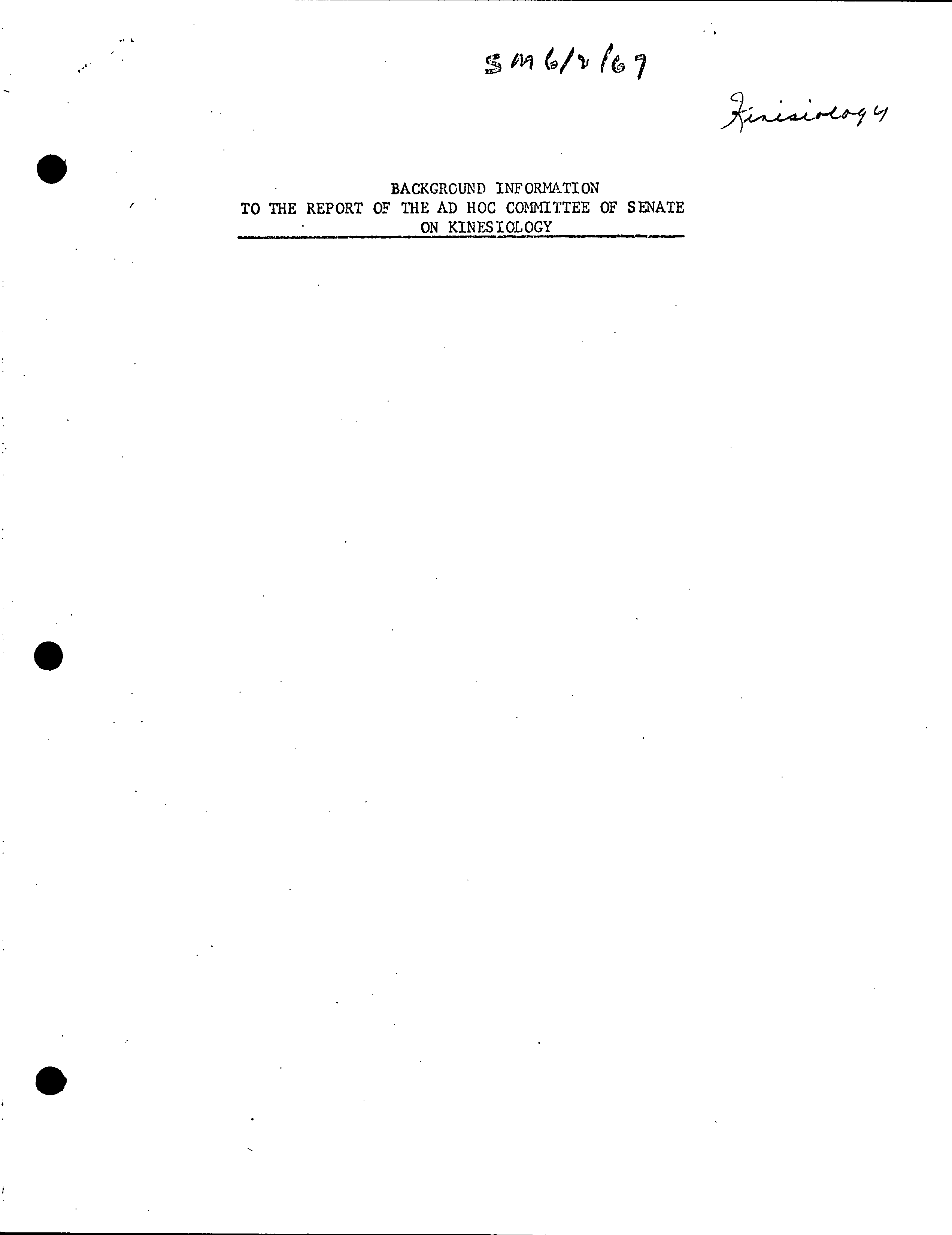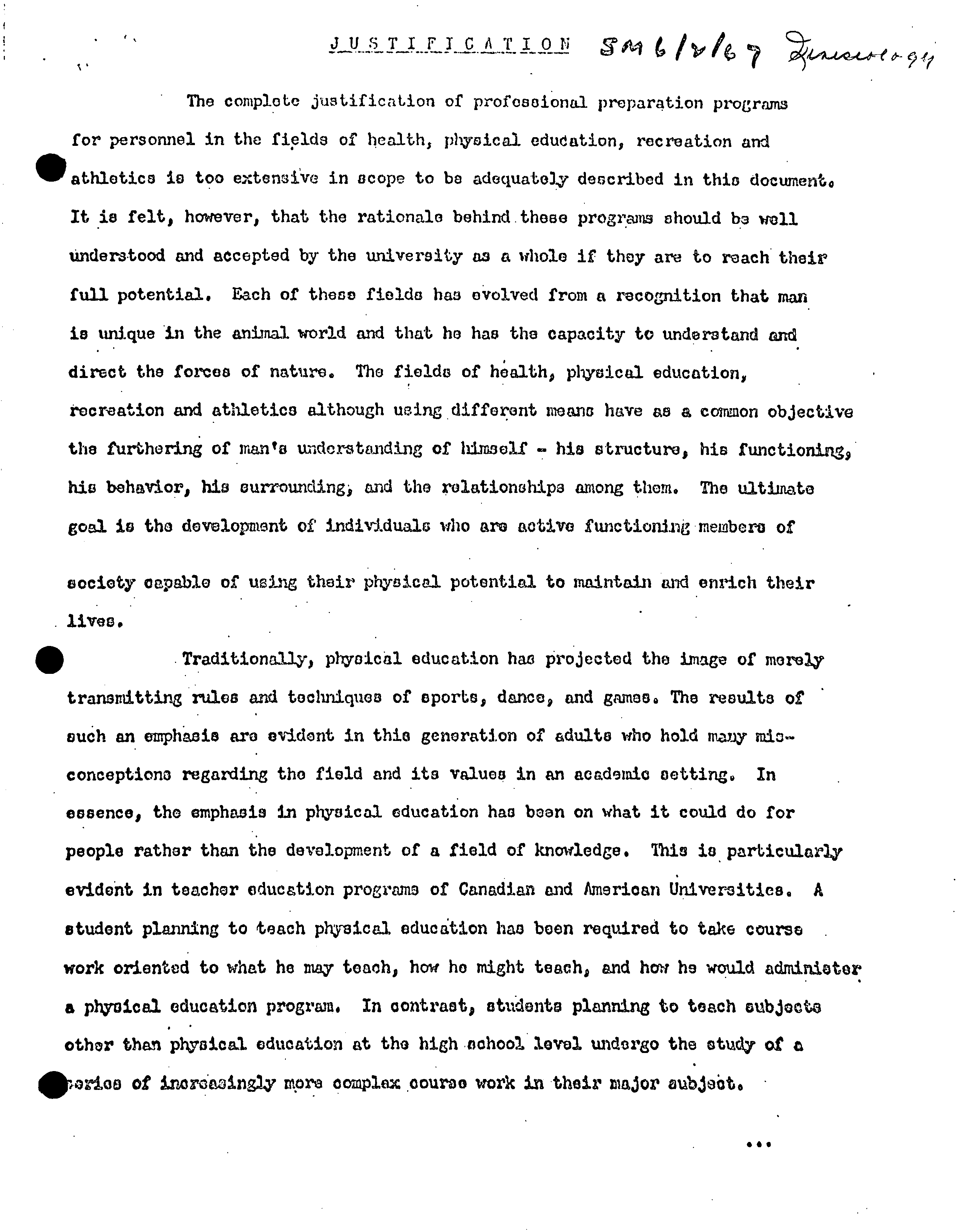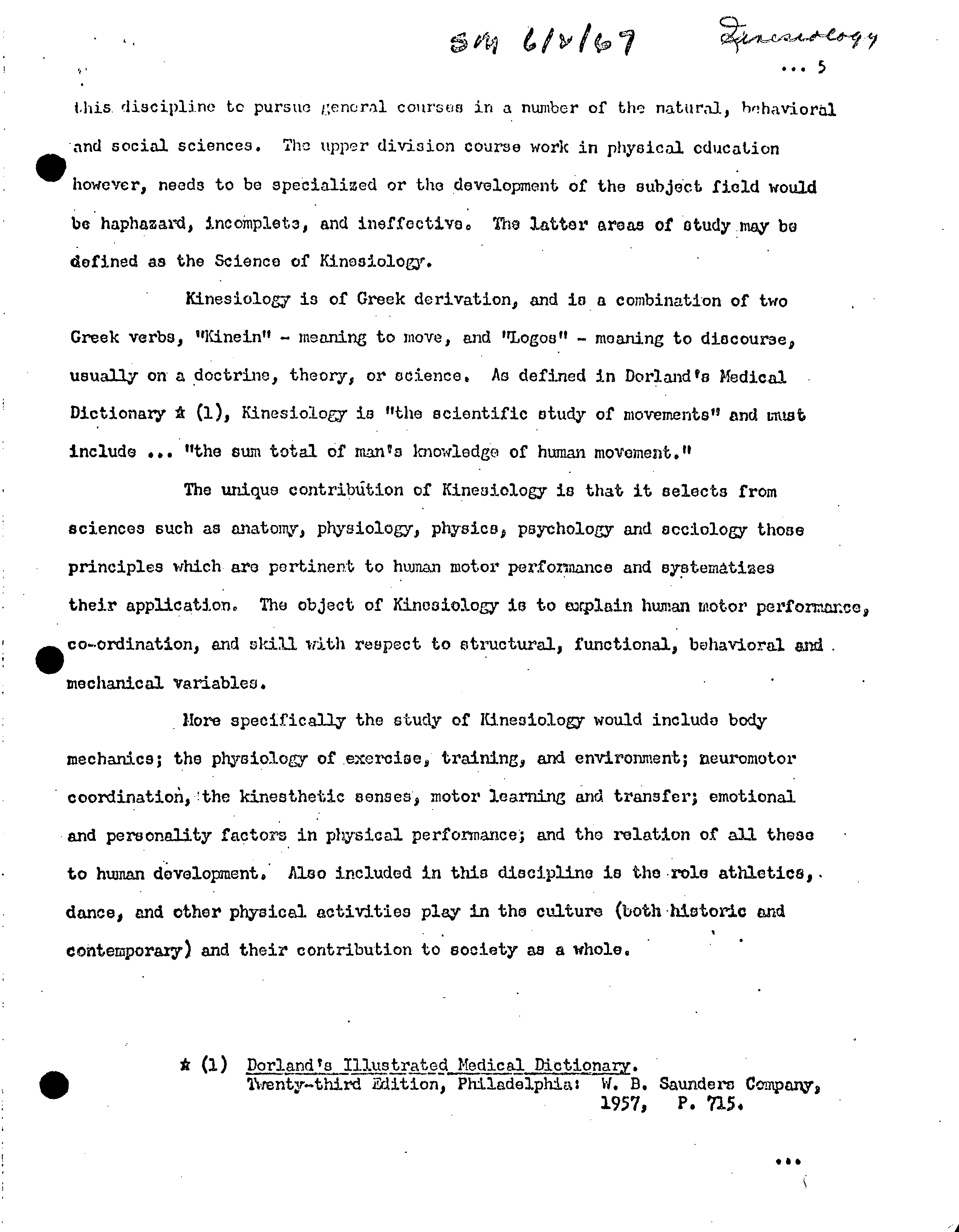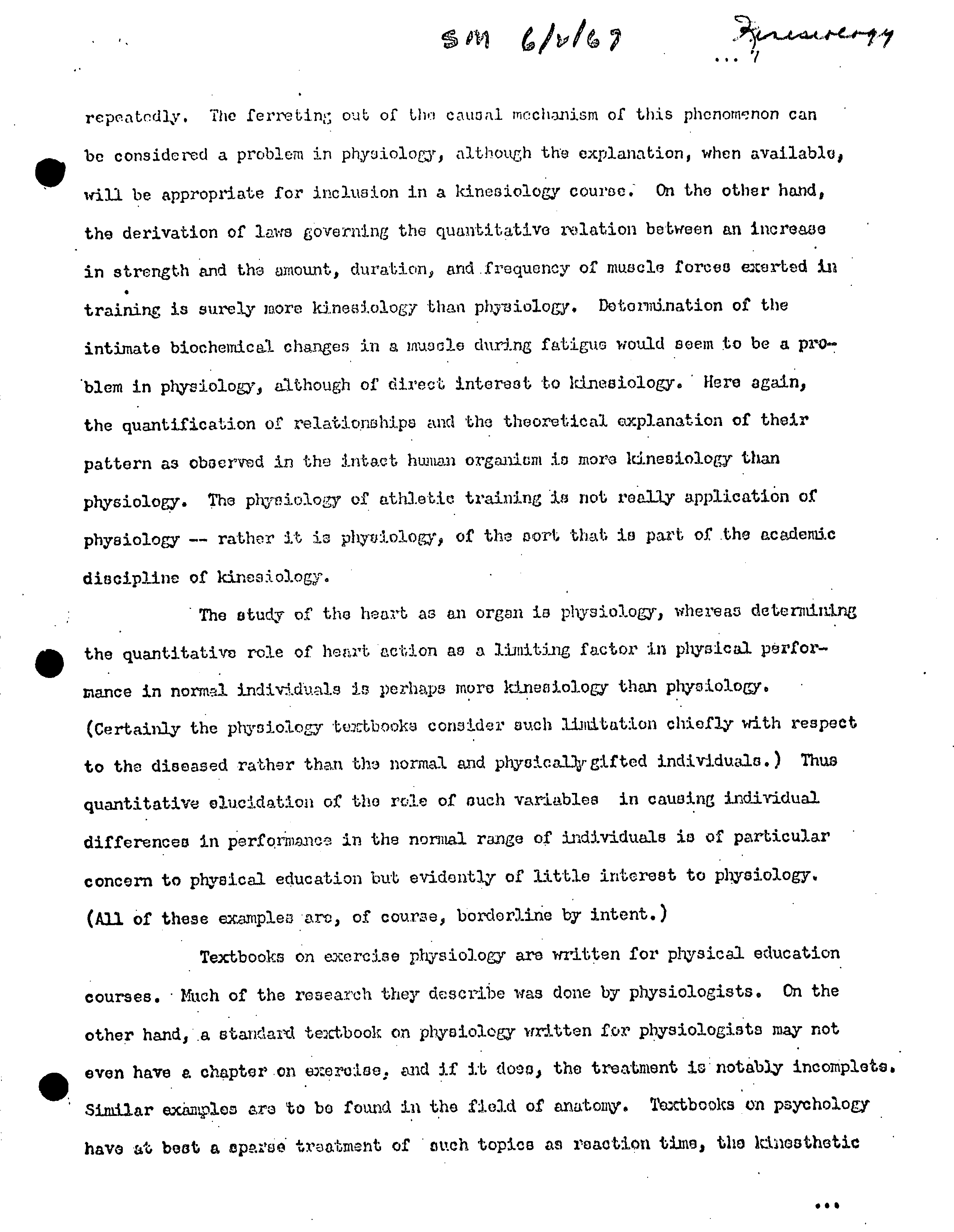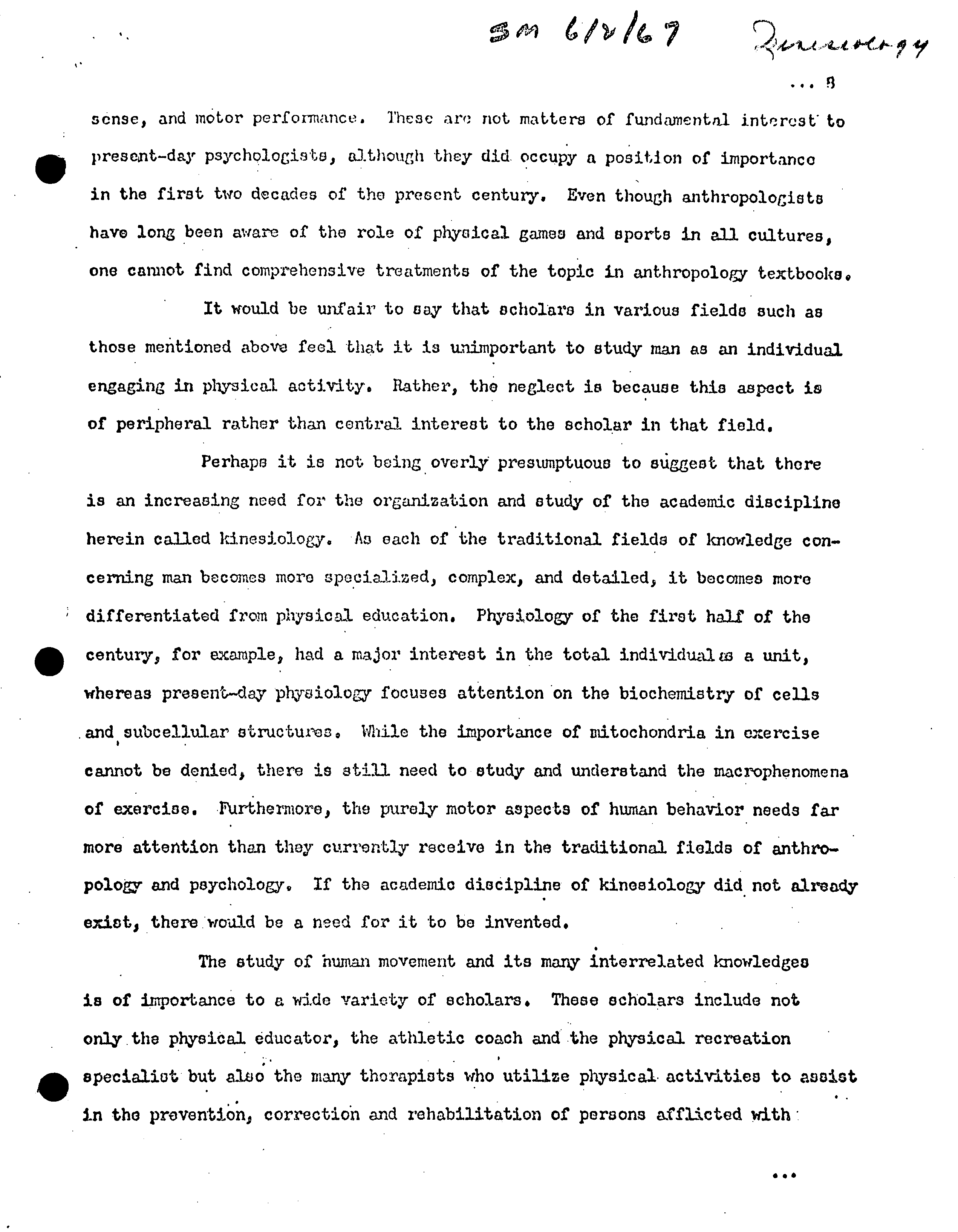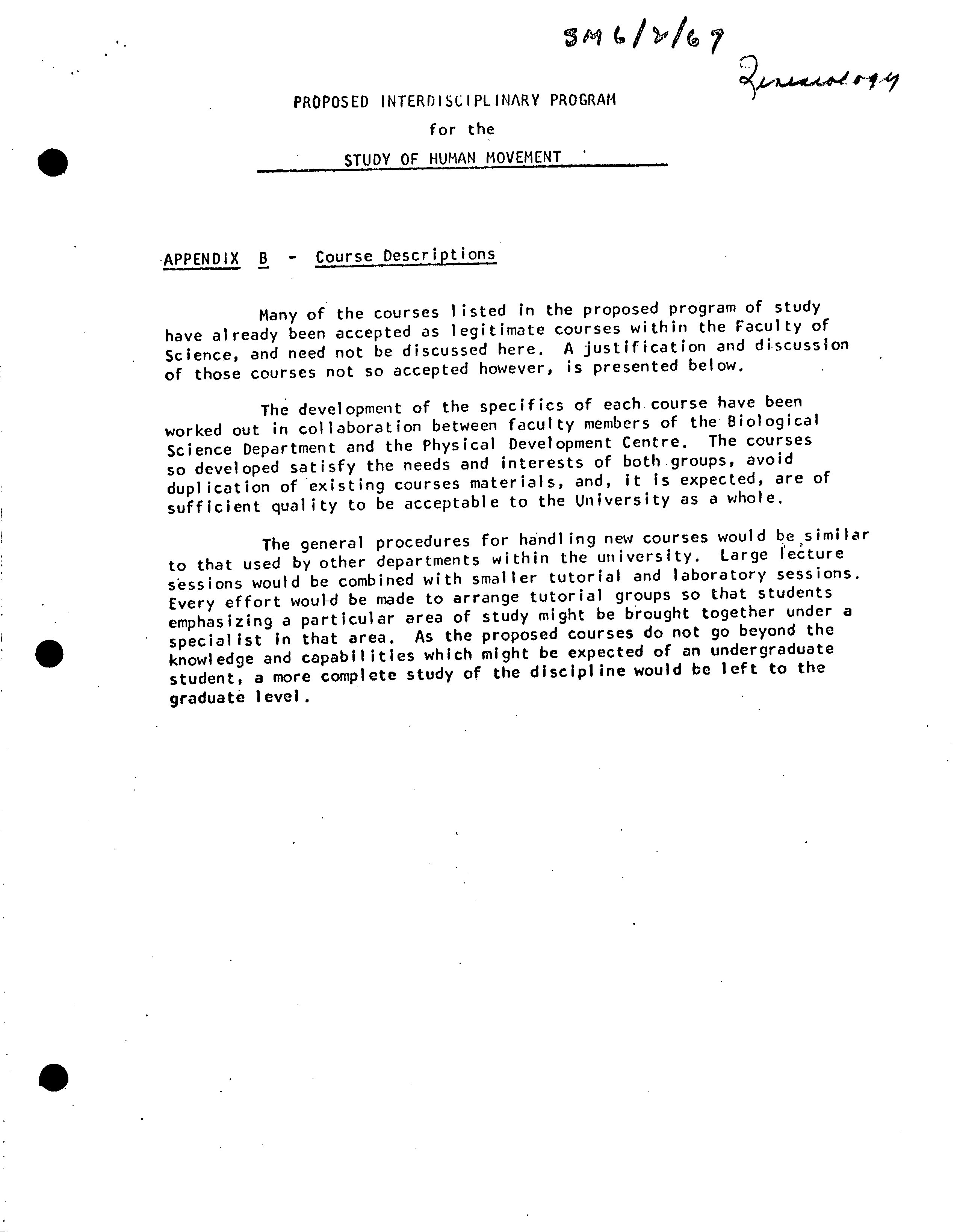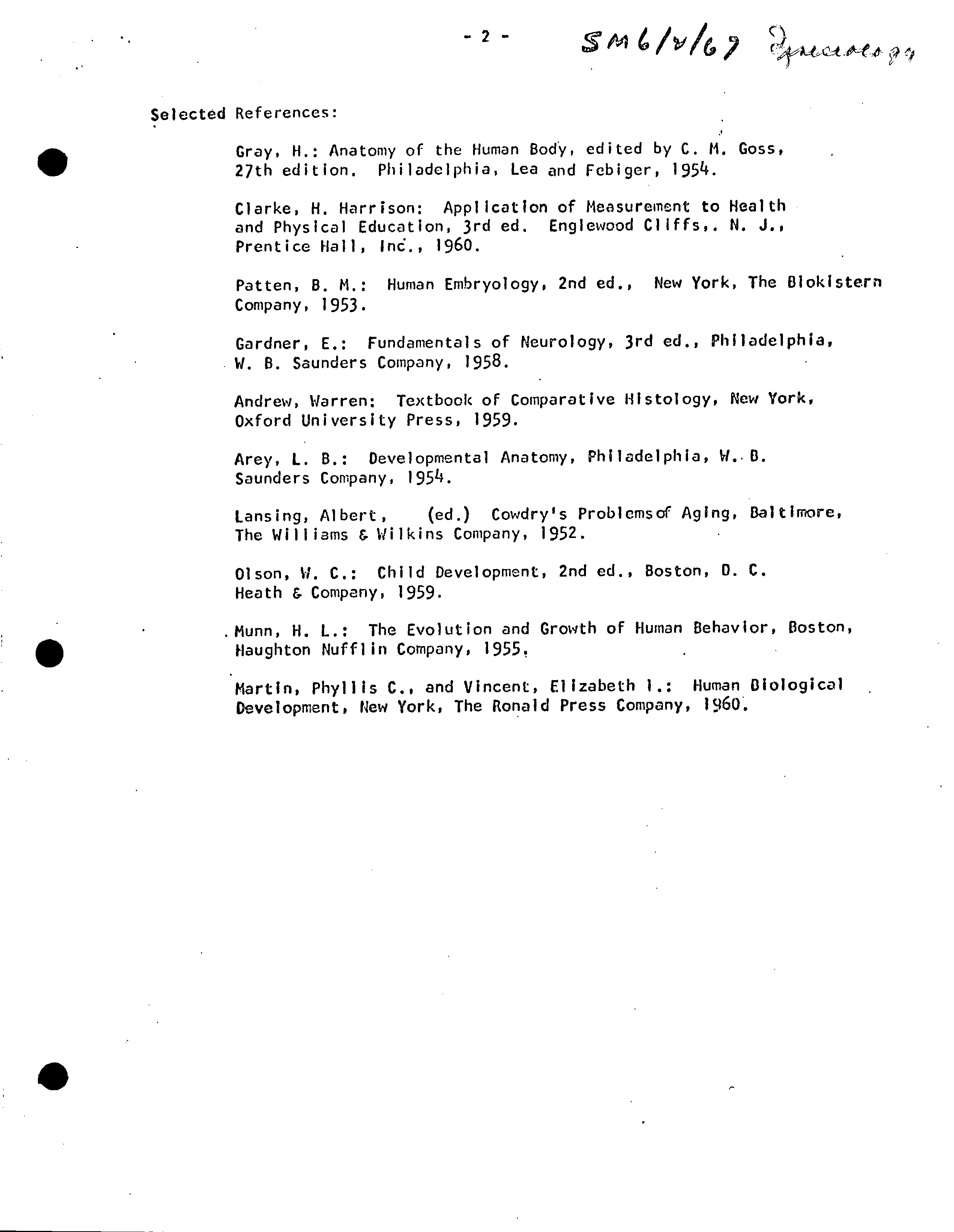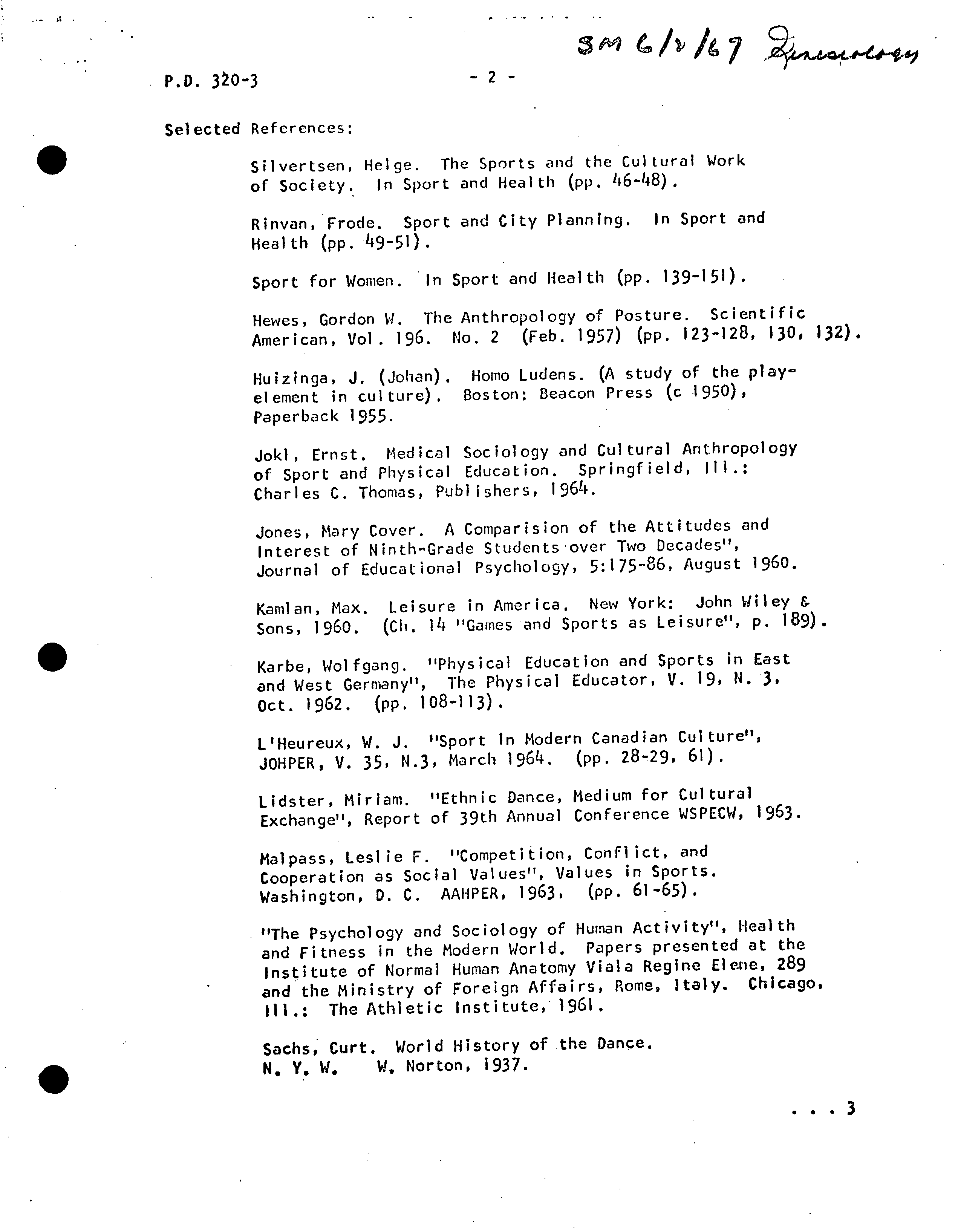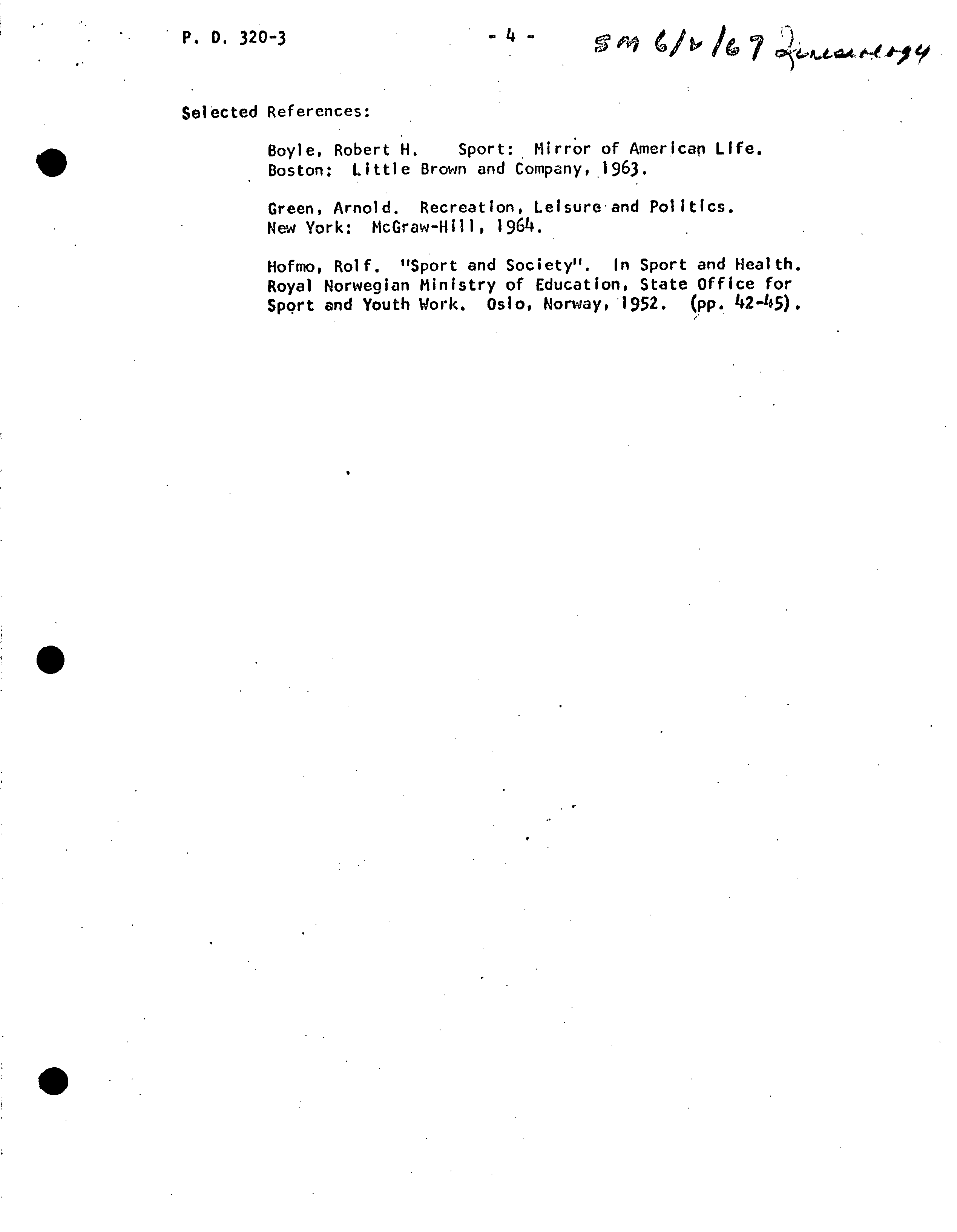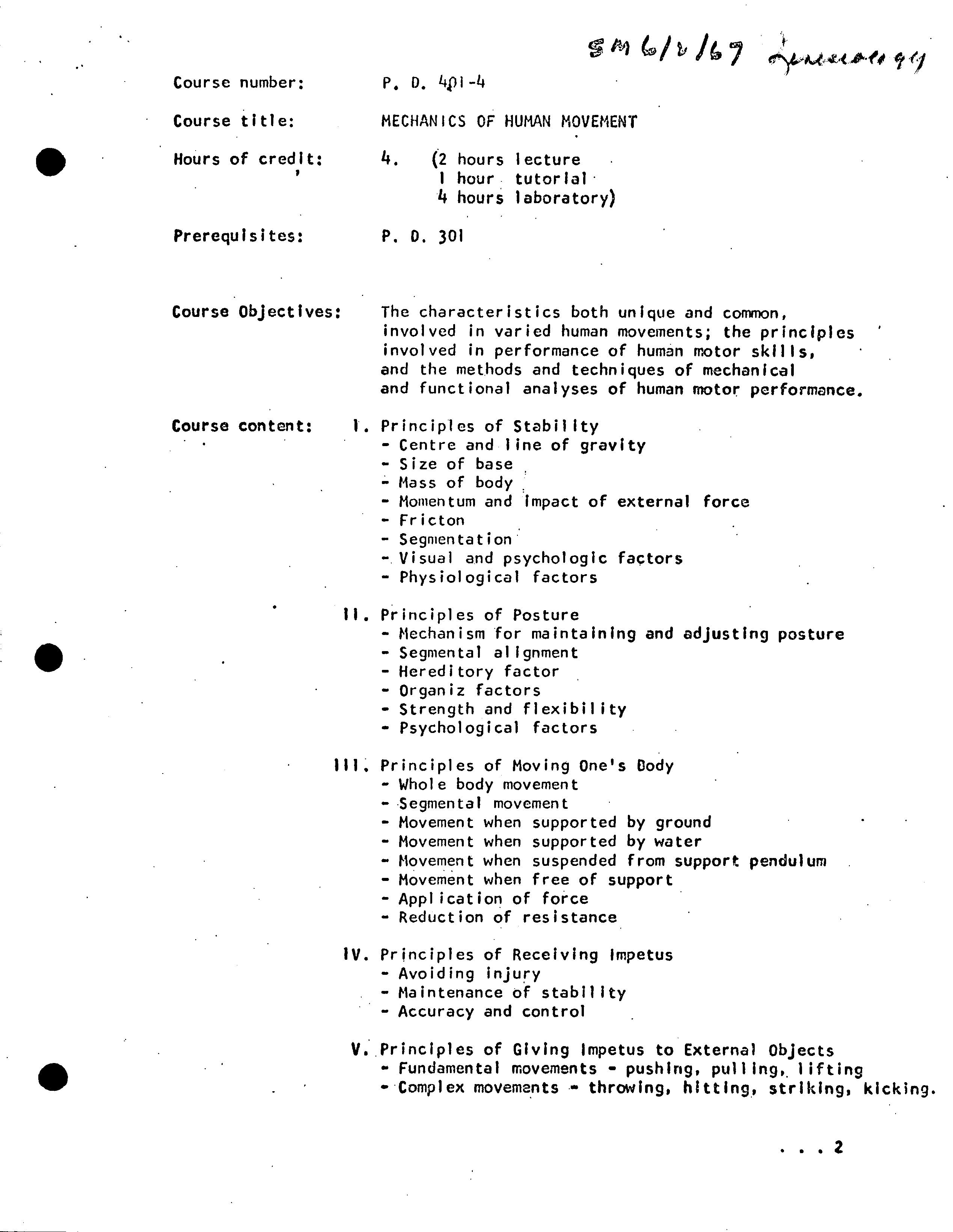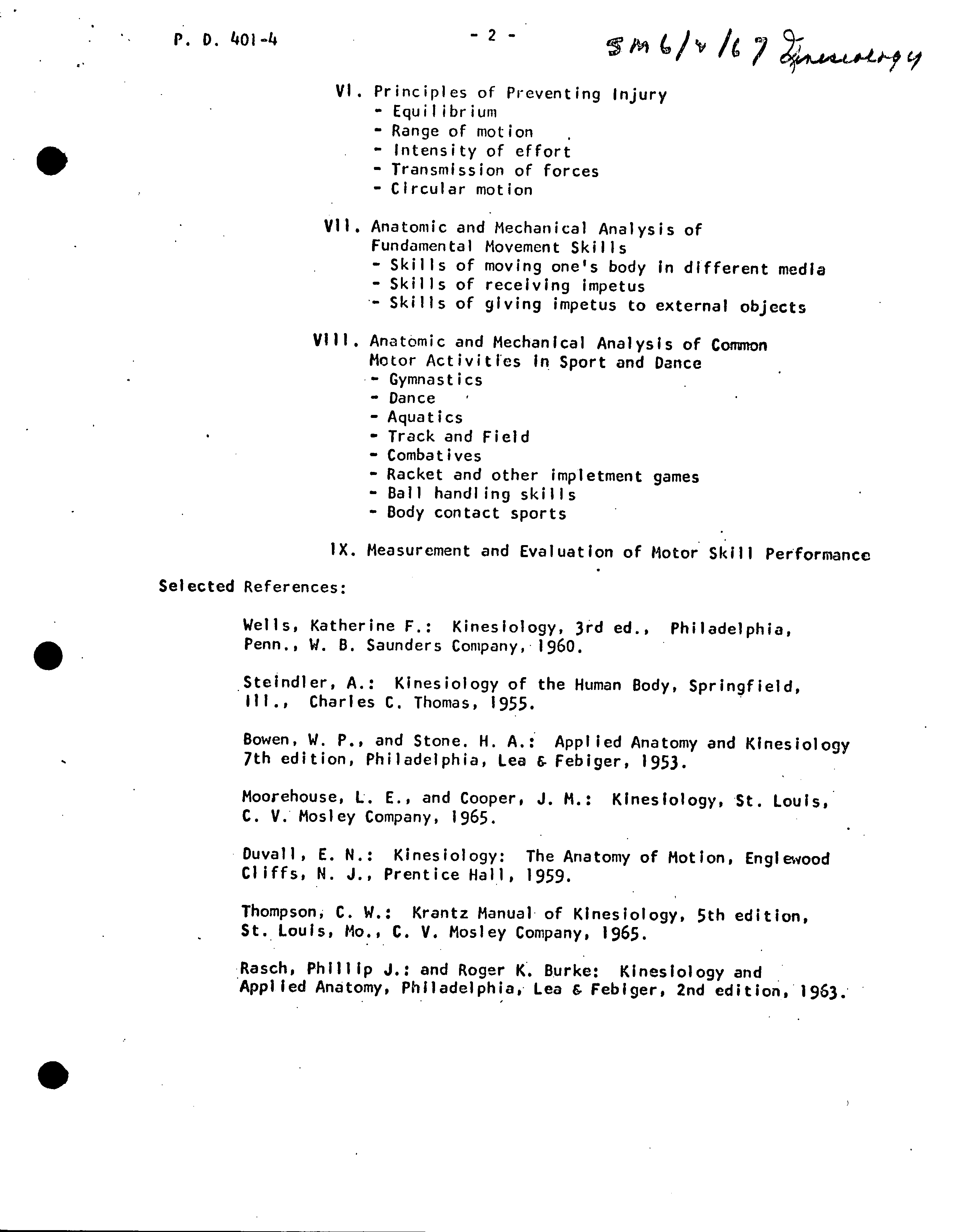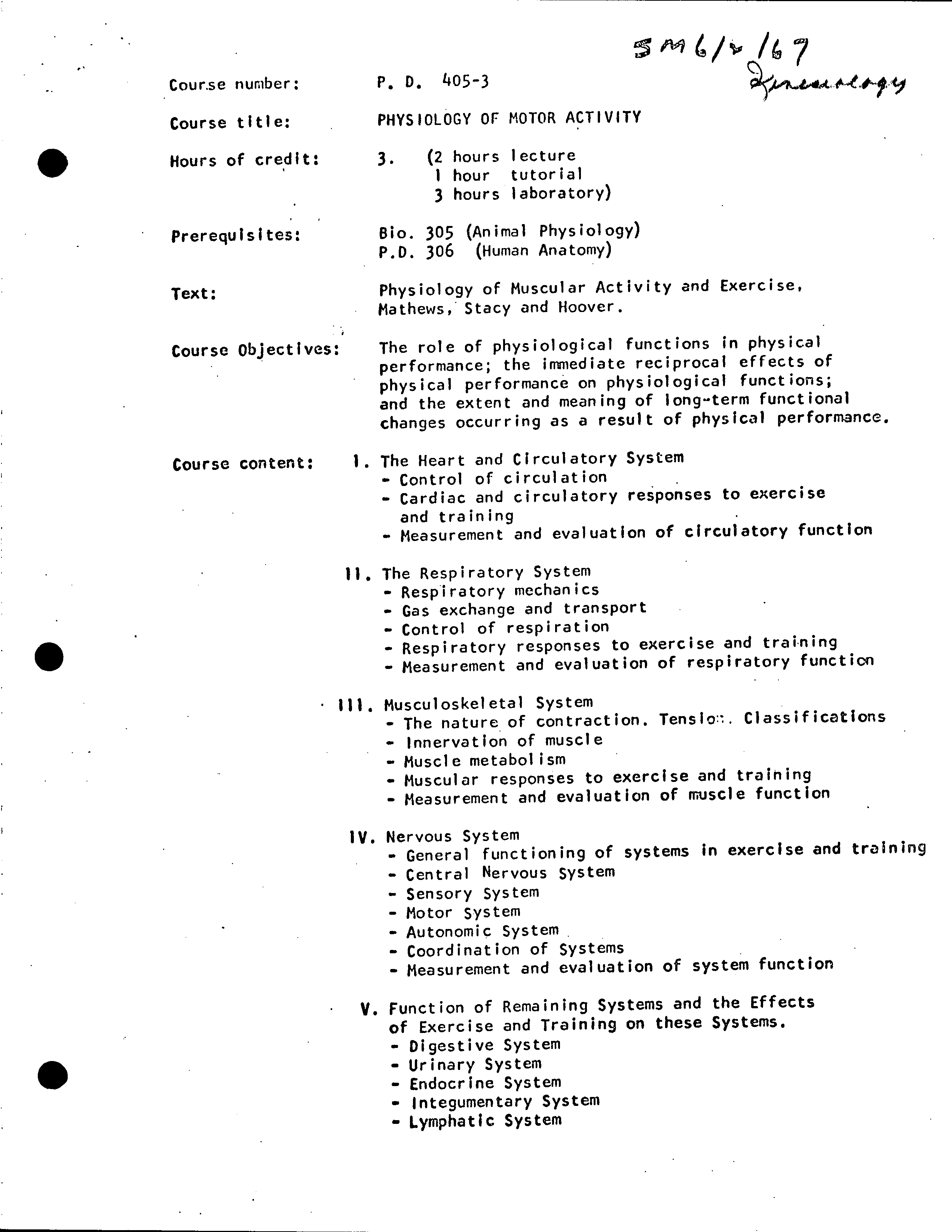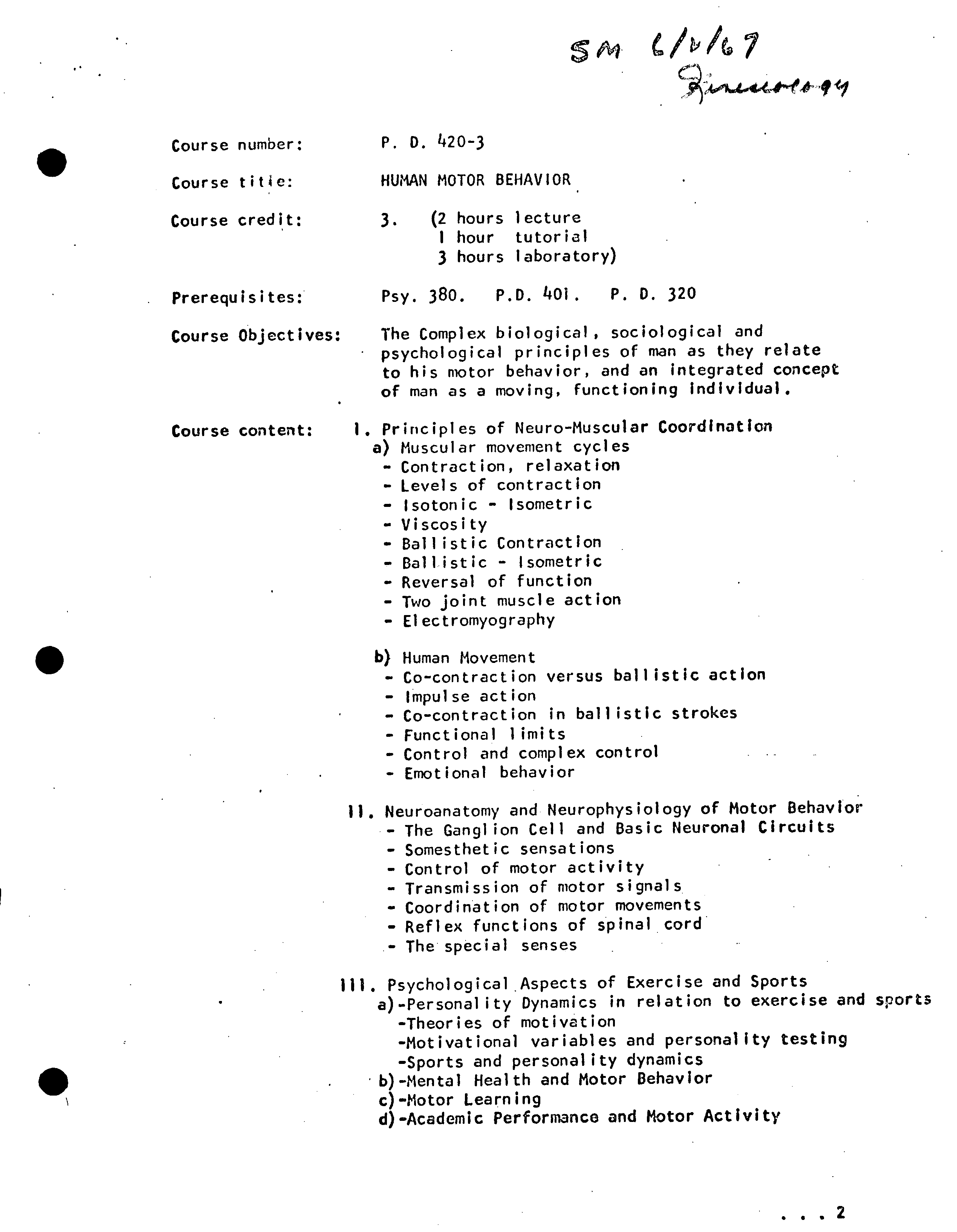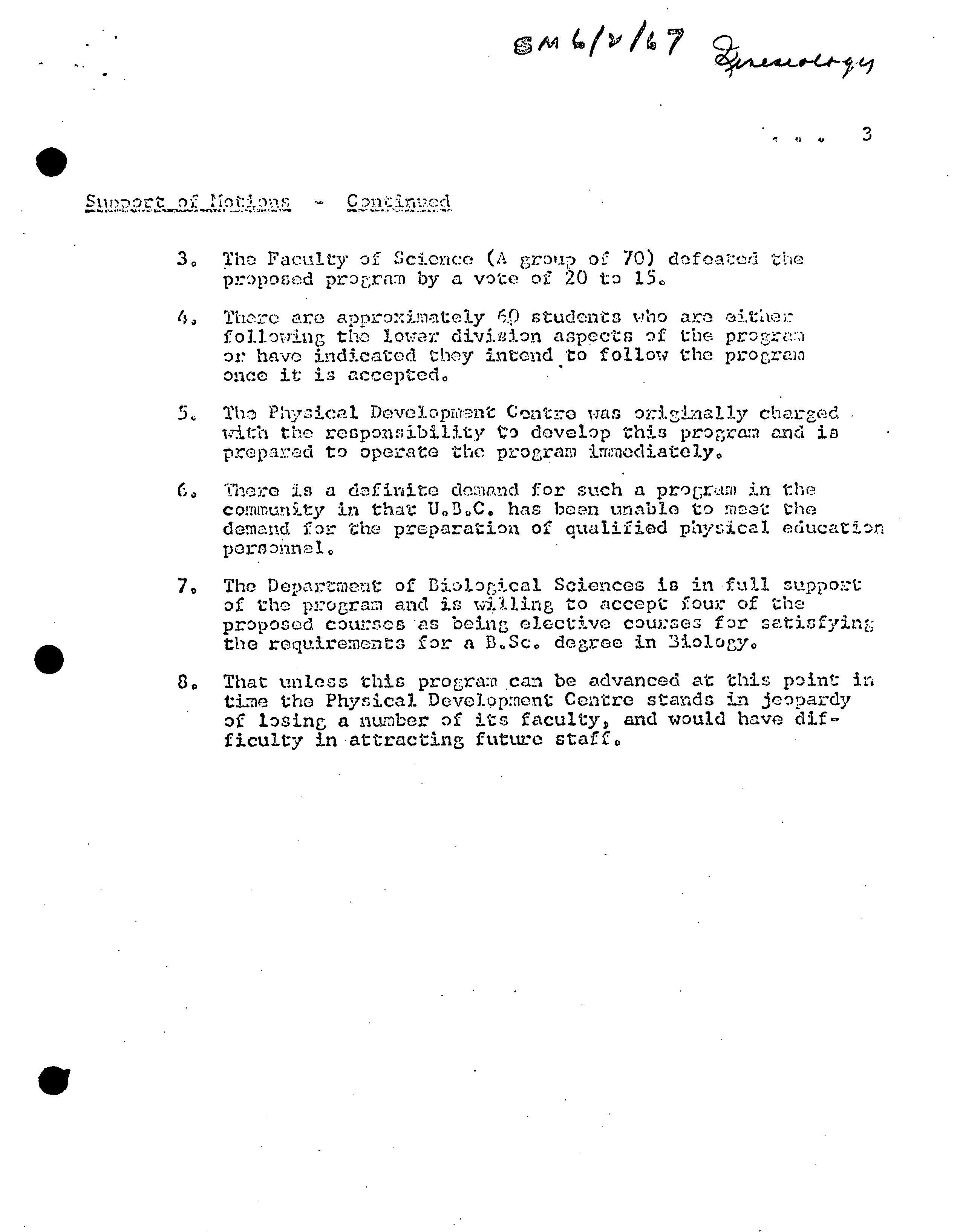S
.
F
?
6
/ v , A
•
411_.
tb
t
1
Y
Ad Hoc Committee of
Senate.
Terms of reference.
1.
Clarify to what extent listed Physical Development courses
are acceptable in the Department of Biölocal Sciences as
courses forming part of the Biology course credits for a
major or honors or Physical Development 320 for sociology
major etc.
2.
Review of course make up to ensure that taking into account
the early state oi development o the science
01
inesiology
they are satsed that the courses are significant. (Experts
may be flown in for consultation at the expense of the
general University travel budget).
3.
Submit proposals to the next meeting of Senate whereby
this program may be offered as a B.Sc major. lam
loath at this time to consider the proliferation of degrees.
Membership.
Science
Arts
Education
Dr. D. G. Tuck
Dr. F. B. Collinge Dr. G. Kirchner
Dr. VT. Vidaver
Dr. J. Tietz
Dr. N. Robinson.
•
To carry out these duties the committee should consult as widely
as possible and the committee has the power to co-opt members.
19t
h
January,
1967.
04 0
R E P 0 R T
To:
President and Senate
Subject: AD HOC COMMITTEE OF SENATE ON KINESIOLOGY
The committee which you appointed on the kinesiology
program, and which you asked me to convene in your letter of
December 12th, has had three meetings since that date
(December 20th, January 10th and January 18th). I should
explain immediately that the committee was late in meeting in
the first place because I was sick and away from the campus
for a week, and there was then an unavoidable delay because
some members of the committee had to leave campus over the
Christmas vacation. This of course, prevented us from meeting
the deadline of January 9th fixed by Senate when the committee
was set up, but I hope you will agree that the many important
problems involved warranted thorough deliberation rather than
over-hasty decision.
We have reviewed the chronological order of events
which led up to the present situation, and Dr. Kirchner kindly
provided all members of the committee with the many relevant
documents, which we have looked through and considered. Your
letter of December 12th set out three terms of reference, and
you may well come to the conclusion on reading this report that
we have ignored all of these. Let me assure you therefore at
the outset that this is not the case. We have tried firstly
to reach a decision which will allow the Department of Physical
EdUcation to make some statement in the Calendar to satisfy the
students whom we understand desire to follow the kinesiology
program. Secondly, we have tried to point the direction in
which the University should go in setting up this and similar
programs in future. We feel this is the most important outcome
of our discussions, which led inevitably to the point where we
were forced to think about how the kinesiology program was to
be administered, and in fact we found it impossible to
,
separate
this from the general matters set out in your terms. of
reference. At our second meeting therefore we adopted two
motions, both of which were passed unanimously by the committee
as then constituted.
The first motion reads:
"This committee recommends that the Senate should establish
a high level inter-faculty body to administer interdisciplinary
programs under terms of reference to be dictated by Senate."
The second motion reads:
"That the administrative inter-faculty body referred to in
motion 1 should be directed by Senate to implement the
..
program on the study of human movement with the intention
that this should be offered as a Bachelor's degree program.
- 2
The point here I think is quite straightforward. The
committee was faced with a choice, either of recommending some
simple motion or motions of the sort set out above, or else
being unable to make any recommendation to Senate at least
S
.
before the end of this semester. This is simply because a
thorough discussion of the details of the kinesiology program
is vital before the program can be implemented, no matter how
many detailed course descriptions are offered, and we could
not do this in the time available. Furthermore it is quite
clear that such a protracted discussion would effectively
prevent the kinesiology program being offered by this
University before September
1968.
It may be therefore that we
have failed to meet the terms of reference set by you in this
respect, but the committee felt that we had very little option
on this matter.
I think it is important that I should set out for you,
and for Senate, .some of the implications which the committee
felt were involved in these two motions. The first point is
that we regard the order in which the motions are presented as
extremely important, and we do not feel that implementation of
the second motion can precede action on the first.
Let me try to explain what we see as the necessary
functions of the high level administrative body referred to in
our first motion. The most important function is that there
should be at the head of this body a full time academic of rank
at least equivalent to a Dean. One of his tasks would be to
ensure that the kinesiology program, and indeed all the future
interfaculty and interdisciplinary programs envisaged at the
•
founding of the University, are run properly under the
conditions which Senate will no doubt lay down. There was
complete agreement on the committee that to administer a
program of the complexity and breadth envisaged for
kinesiology requires much more than the irregular meeting of
various members of faculty from the disciplines involved.
There was no doubt in our minds that a full time person
responsible for these matters is needed in the University if
interdisciplinary programs are to be treated with the.
seriousness which the University intends. We feel that this
person would be responsible, as is a Dean responsible to his
Faculty, for the following matters:
i) He would prevent the proliferation of courses between one
•
Faculty and another. The committee regarded this as a
most important point and we would be strongly against any
system of running interdisciplinary programs which would
result, for example, in courses in biology being offered
by anybody but the Department of Biological Sciences, or
courses in sociology being offered by anybody other than
P.S.A. The committee believes that such duplication is
always possible if an interfaculty program should get out
of control - if one faculty, for example, felt that
required courses in an interdisciplinary program were not
being properly offered in another faculty. Only somebody
• with complete authority over these programs can help to
prevent such proliferation, which would obviously be
•
extremely undesirable from every point of view.
..3../
-
3 -
2)
He, and his associated appointed committees, would rule
on the admissibility of any interfaculty and
interdisciplinary programs which might be suggested in
the future before such programs were presented to Senate
S
for their final approval. This action is parallel to that
taken by the present Faculties under their Deans.
3)
He, and his committees, would take responsibility for
presenting to the appropriate University committees
recommendations on the financing and the faculty staffing
of departments called upon to provide, for an interfaculty
program, service courses which they would not normally
wish to offer as part of their honors or major program.
k)
He, and other faculty involved, would effectively function
as a faculty body and we believe that they would be the
body recommending to Senate that the appropriate students
receive degrees as graduates of the University.
What we are effectively recommending is a body which
will have many of the functions of a separate Faculty but will
not appoint its own teaching staff. The most important point
in our view is that this body, be it Faculty or otherwise,
should be run by a high level academic person, perhaps
equivalent to an academic vice-president as presently
understood in some other North American Universities.
In wording the second motion on p.1, we deliberately
avoided any decision as to the name to be given to the degree
awarded to students who complete the program in kinesiology.
Strong views are held about this in some parts of the
University, but we felt that to debate all the points involved
at this time would hold up acceptance of the program. We
therefore suggest that one of the actions of the proposed
administrative body should be to resolve this in consultation
with the interested parties.
•
As I said at the beginning of this report, we may have
failed to answer some of the terms of reference which you laid
down for us. I would suggest however that we have achieved
something at least as useful, which is to recommend a route
•
whereby a proper, serious and detailed consideration of the
program on kinesiology, and other future interfaculty programs,
can be carried out. Senate would I believe be mistaken if it
allowed itself to go forward with a program in kinesiology
which had not been properly considered in detail; but as I
said earlier, it is quite clear that such a
••
consideration by
the present committee would be long, detailed, and tortuous,
and would effectively prevent kiñesiology being offered before
September
1
68.
This, we believe, was not the wish of Senate,
and we therefore recommend that the calendar should show that
there is to be a degree program in kinesiology without
.
specifically mentioning the name which the degree will be given
when it is awarded.
D. G. Tuck
Convenor
47
BACKGROUND INFORMATION
TO THE REPORT OF THE AD HOC COMMITTEE OF SATE
ON KINESIOLOGY
S
.
4AA
7
PROPOSED
INTERDISCIPLINARY PROGRAM
• for the
STUDY OF HUMAN MOVEMENT
The following paper represents a proposal to the Univer-
sity Senate for the development of an interdisciplinary Program
for the advancement of the study of human movement.. The just-
ification for the development of such a program appears in
Appendix A. The areas of study of concern to the student of
human movement may be identified as being studies related to
human structure and function, human motor development and per-
formance, and the inter-relationships of human development and
social change. The program is designed to permit students to
concentrate their studies in these areas while satisfying the
requirements for a bachelors degree.
The course requirements for the proposed degree program
are as followsg
SCIENCE
jjIRETS
The majority of the course requirements for the first two
years would be identical to those for all biology science majors
so that students might develop a basic foundation in the bio-
logical sciences before preceeding to
a study of man with respect
to movement. It is anticipated that within these courses it will
be possible for students following this program to emphasize
animal biology and in particular as it relates to man.
Love
!icw
Bio.
101-4
- Intro Bio.
•
Bic.
102-4
- Intro. Blo.
310.
201-3
-
Cell Bio. & Bio. Chem.
Bio.
202-3
-
Human Genetics
Bio.
203-3
- Developmental. Bio,
Bio.
204-3
-
Ecology
Chem.
101-3
-
Gen. Chem.
Chem.
106-2
-
Chem. Lab.
Chem.
102-3
- Gen. Chem.
11
Chem.
116-2
-
Chem.
Lab.
Chem.
251-3
Organic Chem. j
Chem.
256-2
- Organic Chem. Lab.
Physics
101-3 • - Gen. Physics
Physics
S
102-3
-
Gen. Physics jJ.
Math
101-3
- Intro, to Statistics
Math
111-3
- Fund. Math 1
Math
112-3
-
Fund.
Math
* P.D.
301-3
* P.D.
303-3
* T.D.
306-4
•
P.D.
320-3
P.D.
401-4
* P.D.
405-3
P. D.
420-3
',
(_•\
'..Z
.
B1o0
305-3 -
Animal Physiology
Bio
316-3
-
Vertebrate Zoology
Bio.
425-3
-
Physiology Laboratory
ARTS RE U1RE11'-ENTS
In
that an understandihg of
human
movement must include
study of man as a social organism, it is further proposed that
a number of Arts courses be included within the course require-
ments for students following this proposed program.
-
Social Structure
-
General Experimental
Psychology
-
Physiological and
comparative Psychology
kQwatz RLMIsion
P..S.A.
121-3
Psych.
201-3
lla
Psych.
380-3
C
PHYSICAL DEVELOPMENT CENTRE REQUIREMENTS
In
that many of the knowledges important to the study of
human
movement are not presently systematically organized into
existing academic courses, the proposed program includes a
number of new courses to be taught by the Physical Development
Centre. (Course outlines are included in Appendix B.)
-
Human Anatomy
Human Growth and Physical
Development
-
Applied Anatomy of Human
Movement
-
Sociology of Human Movement
-
Mechanics of Human Movement
-
Physiology of Motor Activity
-
Human Motor Behavior
*These courses have been accepted by the Department of Biological
Sciences as acceptable elective courses for meeting the
requirements
of a B. Sc. degree with a major
in
Biology.
5 t" I
/V
Aq -1
•
I
3
OUTLINE OF SMSTER HOUR
tJj"T'TTs
SI1EST7PS HOURS
Science • . . . . . .
59
Arts . . . . . . 9
Physical Development Centre 23
Elective
Lower Division •
• 4
Upper Division • • •
Total
120
As there are many directions in which the study of human
movement may be pursued, it
is proposed that the selection of
work for students wishing to
follow an
honors program in
this
area be left to
the discretion of
the student with the approval
of his advisor. The
honors
program would, however, require
students to complete honors paper as well as satisfying the
credit hours requirement.
E
0
J U S T I F I C A T I 0 N
ti,/ti47
^4-4^^
0-- 9 "(/
The complete ju
s
tification of professional preparation
pro g rams
for personnel in the filde of
health, physical
edudation, recreation
and
athletics is too extensive in scope to be adequately
described
in
this document,0
It is felt, however, that the rationale behind.thoso programs should b
.
3 well
understood
and
accepted by the
university
as a whole if they
are
to reach
'
their
full potential. Each of these fields has evolved from a recognition that man
is
unique
'in the animal world and
that
he has the capacity to understand and
direct the forces of nature. The fields of halth,
physical
education,
recreation and athletics although using different means have as a common objective
the
furthering of
man's understanding
of h imself his
structure,
his
functioning,
his behavior, his
ourrounc
l
ing and
the
relationships
among them.
The
ultimate
goal
is
the development of
individuals who are active functioning membero of
society
capable
of
using
their
physical
potential to
maintain and enrich
their
• lives.
Traditionally, physical education
has
projected
the image
of
merely
transmitting rules and techniques
of sports,
dance, and
games. The
results
of
such an
emphasis are
evident
in this generation of adults who hold many mio.
conceptions
regarding
the field and its
values
in an academic netting. In
essence 1
the emphasis in physical education has been on what it could do for
people rather
than
the development of a field of
knowledge.
This is particularly
evident in teacher education
programs
of Canadian
and American Universities, A
student planning to teach
physical
education has been
required
to
take course
work oriented to what he may teach,
how
he
might teach,
and
how he
would
adminiato
a
physical
education program. In contrast,
students planning
to teach subjects
other than
physical
education at
the
high school
level undergo
the study of
of
inorcasingly riorsa
complex course
work
in their major eiubjeät,
ri
//7
'.7
Furthermore, these majors consist of course content far more advanced than
anything that will be taught in high school.
It in the belief of the Physical Development Centre that the
training of a professional physical educator chould bo
founded on
an extensive
study of the theoretical and scholarly imowledges basic to physical education
and the development if specific knowledge6 and skills related to motor activities..
Following completion of such a program. students wishing to teach in the schools
would supplement their major with the necessary courses in methods and other
professional topics. This implies that there exists in physical education an
organized body of knowledge, the acquisition of which is assumed to be. an
adequate and, worthy objective as such, without any demonstration or requirement
of practical
application. It is our
contention that there does
in
fact exist
a scholarly field of knowledge which is unique and basic to physical education.
Physica
l
ucatfL
o
n as an Acadcnüc_Diecipp - King.
SThe academic discipline of physical education encompasses aspects
of the fields of anatomy, physiology, physics, anthropology, sociology, history
and psychology. The focus of attention is
directed toward
the study of inn as
an individual, engaging.
in
motor performances required by his daily life and in
other motor performances yielding aesthetic values or serving as expression of
his
physicsl and competitive nature. An understanding of the comprehensive and
and integrated Icnowledgen of the motor behavior and capabilities of man cannot
be accomplished by studying each of the fields listed above • The areas within
these fields
Vital
to physical education receive only peripheral treatment rather
than
systematic development.
• Sinco the academic discipline of physical education cannot be
Ssynthesized by acurrioula of
selected courses from other dopartmnente another
approaeh must. be
taicen.
It is
first neeeasar for students wishing
to .mater
0..
t
/9/t97
this. discipline to pursue j
enoral courses in a number of the natural, hrhaviorl
and social sciences. The upper division course work in physical cducation
however, needs to be specialized or the development of the subject field would
be haphazard, incomplet3, and ineffective0 The latter areas of study may be
defined as the Science of Kinosiology.
K.inesiology is of Greek derivation, and is
a
combination of two
Greek verbs, "Kinein" - meaning to move, and
fLogo -
moaning to discourse,
usually on a doctrine,
theory, or science. As defined
in
Dorland's Medical
Dictionary A (1), Kinesiology is "the scientific study of movements" and irnwt
include •.. "the sum total of man
e
s knowledge of human movement,"
The unique contribution of Kinesiology is that it selects from
sciences such as anatomy, physiology, physics, psychology and sociology those
principles which are
portinen to human motor performance and systemties
their application The object of Kinosiology is to ucplain human motor performance',
w
o-ordination, and skill with respect to structural, functional, behavioral
and
mechanical variables.
hors
specifically the study of Kinesiology would include body
mechanics; the physiology of exercise, training, and environment; neuromotor
coordinatioii, the kinesthetic senses motor learning and transfer; emotional
and personality factors in physical performance; and the relation of
all
these
to human
development, Also included in this discipline
is the role athletics,
dance, and other physical activities play
in
the culture
(both historic and
eOfltemporaI7) and their contribution to society as a whole.
* (1) Doris_
Illustrated Medical
ion.
nty
.
third Edition, Philadelphia: W. B. Saunders Company,
1957s
P. 7154
'I,
seo
6/v A 7
^=6
n
Kincsiology, as a field of study, does not consist, or the applicatio
n
of anthropology,
physiology, psychology, and
the
Uke
to the study of physical
• activity.
On
the contrary, it has to do with the study, as a discipline, of
movement and its relationships to
certain
aspects of anthropology, physiology,
psychology, and other appropriate fields.
The
student who majors in this cross-
disciplinary field of knowledge will not be a
physiologist or a psychologist or
an anthropologist, since there has necessarily been a restriction in breadth of
study within each of the traditional fields. Moreover, the emphasis must
frequently be placed on special areas within each of these fieldø. This is
comparable to the situation in
a number
of the disciplines. A biochemist, for
example,
is
necessarily deficient in his breadth of training as a chemist, and
he is also
necessarily narrow
as a biologiet.
Nevertheless,
he is a more competent
biochemist
than
is a
chemist or a biologist.
Fróbleuis certainly occur in deliTniting
the
field of knowledge out-
lined above. The development of personal skill in motor performance is without
question a worthy objective in itself, but it should not be confused with the
academic field of knciwledge. Similarly, technical competence in measuring
a
chemical reaction, or computational skill in mathematicu, are not components of
the corresponding fields of knowledge. Learning the rules and strategy of
sports may well be intellectual, but it is highly doubtful if a course on rules
and strategy can be justified a3a major component of an academic field of
knowledge at the upper division. university level.
One
may
well
raise such questions as where, for instance,
is the
borderline between a field such as physiology and the field of kinesiology?
}!o simple definitive statement
is possible, but it is not difficult to show
examples that illustrate the region of demarcation. The existence of oxygen
debt is
physiology;
the role of
oxygen
debt in various
physical performances
is
kinooiolog. We do not know
why
a muscle
becomes stronger when
it is exercised
•Io
rep'ctt.ndl,y. The ferret;in out of ths: causal
mCCIlan13m
of this phcnornnon can
. be considered a problem in physiology, although the explanation, when available,
will be appropriate for inclusion in a kinesiology course. On the other hand,
the derivation of laws governing the quantitative relation between an inerewie
in
strength and the amount., duration, and frequency of muscle forces exerted in
training is surely more kinesJ.ology than physiology. Determination of the
intimate biochemical changes in a muscle during fatigue would seem to be a pro-
blem
in
physioiogy,
although of direct interest to ldneaiology. Here again,
the quantification of relationships and the theoretical
explanation of their
pattern as observed in the intact human orgenicrn is more ld.necioiogy than
physiology. The physiology of athletic training is riot really application of
physiology -- rather it is physiology, of the sort that; is part; of the academic
discipline of kinosiology.
The study of the heart as
an
organ is
pliology, whereas determining
the quantitative role of hearts action as a limiting
factor in physical perfor-
mance
in
normal individuals is perhaps more kinesiology than physiology.
(Certainly the physiology tuzftboaka consider such limitation chiefly with respect
to the diseased rather than the normal and physlcaiJy gifted
individuals.) Thus
quantitative elucidation of the role of ouch variables in causing individual
differences in perfqrmsnee in the normal range of individuals is of particular
concern to
physical
education but evidently of little interest to physiology.
(All
of
these
examples are, of course, borderline by intent.)
Textbooks on exercise physiology are written for physical education
courses. Much of the research they describe was done by physiologists. On the
other
hand, .a standard textbook on physiology written for physiologists may not
•
even
have a chapter on exercIse, and if it
(101)0j
the treatment is notably incomplete
Similar examples are to be found in the field of anatomy. Textbooks an psychology
have at boot a
sparse treatment of such
topics as reaction time, the kinesthetic
0•
0
?
1
...
sense, and motor performance. These are riot matters of fundamental interost to
• present-day psychologists, although they did. occupy a position of importance
in the first two decades of the present century. Even though anthropologists
have long been aware of the role of physical games and sports in all cultures,
one cannot find comprehensive treatments of the topic in anthropology textbooks.
It would be unfair to cay
that scholars in various
fields
such as
those mentioned above feel that it. is unimportant to study man as an
individual
engaging in
physical activity. Rather, the neglect is because this aspect is
of peripheral rather than central interest to the scholar
in
that field.
Perhaps it is not being overly: presumptuous to suggest that there
is an increasing need for the
organization and study of
the academic
discipline
herein called kinesiology. As each of the traditional fields of kncnr1edge con-
cerning man becomes more specialized, complex, and detailed, it becomes more
differentiated from physical education. Physiology of the first half of the
century, for example, had
a
major interest in the total individual a unit,
whereas present-day physiology focuses
attention
on the biochemistry of cells
and cube efl.ular structures • While the importance of
mitochondria
in exercise
cannot be denied, there is still need to study and understand the mn.acrophenomena
of exercise.
•Iktrthermore, the purely motor aspects of human behavior needs far
more attention than they currently receive in the traditional fields of anthro-
pology and psychology. If the
academic discipline of kinosiology did not already
exist, thore:wouid be a need for it to be invented.
The study of human movement and its many Interrelated knowledgea
i8
of
importance to a wide variety of scholars. These scholars include not
•
only
the physical educator, the athletic coach and the physical recreation
specialist but also the many therapists who utilize physical . activities
to assist
in the
prevention, correctio'n and rehabilitation of persons afflicted with
nm
#ti
'/,/ 7
diseascs and injiiric
which :iCfeci, thcJ.r inot.or function. Recently a considerable
amount of interest in
the knowli:rlr,eo in Lhi3
area has also been exhibited by
persons concerned with working with the mentally retarded, and the emotionally
disturbed. The medical profession as
well
has begun to recognize the importance
of the study of physical medicine and the need for practitioners to understand
the importance of exercise and motor activities in the prevention and correction
of
many illnesses. Another group of individuals deeply concerned with the study
of man as a physical belig are those who work
in
the many
fields of
health and
health education. The study of kinesiology as an academic discipline therefore*
is becoming of increasing importance
to a wider
and
wider
group of professional
and technical occupations. The training of professional workers
in each of
these different occupations requires from slightly to markedly diffôrent pro-
fessional and technical experiences but have
similar needs with
r espect to
scholarly and theoretical experiences.
.
0. I
I
SM It. / ^VA 7
PROPOSED INTERDISCIPLINARY PROGRAM
.
for the
STUDY OF
HUMAN MOVEMENT
APPENDIX B - Course Description
s
Many of the courses listed in the proposed program of study
have already been accepted as legitimate courses within the Faculty of
Science, and need not be discussed here. A justification and discussion
of those courses not so accepted however, is presented below.
The development of the specifics of each course have been
worked out in collaboration between faculty members of the Biological
Science Department and the Physical Development Centre. The courses
so developed satisfy the needs and interests of both groups, avoid
duplication of existing courses materials, and, it Is expected, are of
sufficient quality to be acceptable to the University as a whole.
The general procedures for handling new courses would be similar
to that used by other departments within the university. Large lecture
sessions would be combined with smaller tutorial and laboratory sessions.
Every effort woul-d be made to arrange tutorial groups so that students
emphasizing a particular area of study might be brought together under a
specialist In that area. As the proposed courses do not go beyond the
knowledge and capabilities which might be expected of an undergraduate
student, a more complete study of the discipline would be left to the
graduate level.
0
.
.
3It1
/'hy
Course number:
P. D. 303-3
Course title:
HUMAN GROWTH and PHYSICAL DEVELOPMENT
Credit Hours:
3.
(2 hours lecture
1 hour tutorial
3
hours laboratory)
Prerequisites:
P. D. 306 (Human Anatomy)
Course Objectives:
The processes, stages and characteristics of
normal human physical development, the factors
affecting this development, and the genetic and
environmental variations in human motor behavior.
Course contont:
1. Fundamental Concepts of Physical Growth and Development.
- Terminology and meaning
- General Principles
- Sequences and classification of body changes
- Genetic foundations
1!. Characteristics and progress of pre natal physical
growth and development.
- Periods of development and characteristics
- Factors related to size at birth
Ill. Characteristics and progress of post natal physical
growth and development.
- Neural
- Glandular
- Physical a) bodily systems
b)
body shape and form
c)
motor development
- Factors affecting post natal growth and development
a)
Genetic
b) Gravitational
c)
Traumatic
ci) Disease
RI.
Motor activity
and its effects on the
retardation of normal physical growth
- Immediate or short term effects
- Secular effects
- Age and activity needs
- Appropriate and inappropriate motor
for optimal physical growth and dev
advance and
and development.
activities
l opment.
V. Measurement and evaluation of growth and developmental
characteristics.
- Physical Growth Studies
- Methods and instruments of measurement
- Analysis of data
fl
- 2 -
S
M
Selected References:
S
Gray, H.: Anatomy of the Human Body, edited by C. 11. Goss,
27t h
edition. Philadelphia, Lea and Febiger,
1954.
Clarke, H.
Harrison:
Application of
Measurement to Health
and Physical Education, 3rd ed. Englewood Cliffs,. N. J.,
Prentice Hall, Inc., 1960.
Patten, B. H.: Human Embryology, 2nd ed., New York, The Biokistern
Company,
1953.
Gardner, E.: Fundamentals of Neurology, 3rd ed., Philadelphia,
W. B. Saunders Company,
1958.
Andrew, Warren: Textbook of Comparative Histology, New York,
Oxford University Press,
1959.
Arey, L. B.: Developmental Anatomy, Philadelphia, W. B.
Saunders Company,
1954.
Lansing, Albert,
(ed.) Cowdry's Problcmsof Aging,
Baltimore,
The Williams & Wilkins Company,
1952.
Olson, W. C.: Child Development, 2nd ed.,, Boston, D. C.
Heath & Company,
1959.
Munn, H. 1.: The Evolution and Growth of Human Behavior, Boston,
Haughton Nuffl in Company,
1955,
Martin, Phyllis C., and Vincent, Elizabeth 1.: Human Biological
Development, New York, The Ronald Press Company, 1960.
0
/l/(.
Course number:
P. D. 306-3
Course title:
HUMAN ANATOMY
Hours of Credit:
3. (2 hours lecture
I hour tutorial
3 hours laboratory)
Prerequisites:
Bio. 316 (Vertebrate Zoology)
Text:
"Introduction to Human Anatomy"- Carl C. Francis.
Course Objectives:
The concepts and knowledge
of
human microscopic and
macroscopic anatomy which lead to a comprehensive
understanding of the physiological, mechanical and
ontogenetic aspects of human movement.
Course content:
1. Fundamental anatomic concepts
- Directional terms
- General orientation planes and axes
- Surface anatomy and land marks.
11. Skeletal System
- Gross and microscopic bone structure
-Classification and organization of bones
- Articulations - structural characteristics
Muscular System
- Gross and microscopic structure and composition
•
- Gross organization of skeletal musculature
- Head and Spinal Column
- Thorax
- Upper extremity
Lower extremity
- Trunks
IV.
Nervous System
- Classifications and microscopic structure
- Structural Organization
- The motor unit
- Plexes
- Spinal Cord
- Brain
- Autonomic Systems
- Sensory Systems
V.
Circulatory System
- Structural Organization and Characteristics
- Microscopic Structure
of
Organs and Vessels
VI.
Respiratory System
•
- Structural organization and characteristics
- Microscopic structure
of
respiratory apparatus
- Volumes and Sinuses
. . . 2
P. 0. 306-3
7
5
c/
Al
•
VU.
Structural Organization and Characteristics
of Complimentary Systems.
- Digestive System - alimentary canal, accessory organs
- Urinary System - kidneys, ureters, bladder and urethra
- Endocrine System - hypophysis, suprarenal, thyroid,
parathyroid, pancreas, ovaries and testes.
- Lymphatic System - vessels, ducts, nodes, spleen,
tonsils, thymus.
- Integumentary System - skin, hair, glands.
V1U. Measurement and Evaluation of Structural Characteristics
- Anthropometry
- Somatotyping
- Posture
Additional References:
GROSS
P14ATO1IY, TEXTBOOKS.
Cunningham, D. J.,: Cunningham's Text-Book of Anatomy, edited
by J. A. Brash, 9th ed. New York, Oxford University Press, 1951.
Gardner, E., Gray, D. J., and O'Rahilly, R.: Anatomy,
Philadelphia, W. B. Saunders Company, 1960.
Grant,
J.
C. B.: Method of Anatomy, 6th ed. Baltimore,
•
The Williams & Wilkins Company, 1958.
Gray, II.: Anatomy of the Human Body,edlted byC. H. Goss,
27t
h
edition, Philadelphia. Lea & Febiger, 1959.
Lockhart, R. 0., et al.: Anatomy of the Human Body.
Philadelphia, J. B. Lippincott Company, 1960.
Morris, H.: Morris' Human Anatomy, edited
by J. P. Schaeffer,
11th
ed. NewYork, McGraw-Hill Book Company (Blakiston Div.) 1953.
Woodburn, IL 1.: Essentials of Human Anatomy.
2nd edition.
New York, Oxford University Press, 1961.
GROSS
ANATOMY, ATLASES.
Anson, B. .1.: Atlas of Human Anatomy,
Philadelphia, W. B. Saunders Company, 1950.
Grant, J. C. B.: Atlas of Anatomy. 3rd edition.
Baltimore, The Williams & Wilkins Company, 1951.
Jamieson, E. B.: Illustrations of Regional Anatomy, 6th edition,
Baltimore,. The Williams & Wilkins Company, 1959.
Sobotto. J.,, and IJhlenhuth, E,, Atlas of Descriptive IIumn
Anatomy, 7th ed. New York, Harper Publishing Company, Inc. 1957.
1
•1/
,•:
.
PD.3o6-3
SM.46A
Spalteholz, W.: Hand Atlas of
Human Anatomy, edited by
L. F.
Barker. 7th ed. Philadelphia. J. B. Lippincott Co.
1943.
Toldt, C.: Atlas of Human Anatomy, edited by M. E. Paul,
2nd ed. New York, The tlacmil lan Company, 19141
(reIssue 39146).
MICROSCOPIC
ANATOMY
Bloom, W., and Fawcett, D. Textbook of HistoIoy.
8th ed. Philadelphia, W. B. Saunders Company,
1962.
Dl Fiore, M. S. H. Atlas of Human Histology.
Philadelphia, Lea & Febiger (reprinted
3961).
Finerty, J. C. and
Cowdry, E. V.: Textbook
of Histology,
5th ed. Philadelphia,
Lea &
Febiger, 1960.
Greep, IL 0., ci al.: Histology, New York,
The Blekiston Company, 1954.
Ham, A. W., and Leeson, T. C.: Histology, 14th ed.
Philadelphia, J. B. Lippincott Company, 1963.
Jordan, H. E.: Textbook of Histology, 9th edition.
(rev.) New York, D.
Appleton
Company, 1952.
Wilson, G. B. and Morrison,
J.
1.: Cytology, New York,
Reinhold Publishing Corporation, 1963.
ANATOMY OF THE NERVOUS SYSTEM
Crosby, E. C., Humphrey, T., Lauer, E., et al:
Correlative Anatomy of the Nervous System.
New York, The Macmillan Company, 1962.
Krieg, W. J. S.: Functional
Ne.uroanatoniy, 2nd edition,
The Blakiston Company, 1953.
Kuntz,. A.: Autonomic Nervous System, 4th edition.
Philadelphia, Lea & Febiger, 1953.
Ranson, S. W., and Clarke, S. L.: Anatomy of the Nervous
System, 10th edition. Philadelphia, W. B. Saunders Co.
1.959.
Rasmussen, A. 1.: Principal Nervous Pathways,
L
th edition.
New York, The Macmillan Company.
1952.
0
Course number:
P. D. 301-4
Course title:
APPLIED ANATOMY OF HUMAN MOVEMENT
Hours of Credit:
11.
(2 hours lecture
I hour tutorial
L e
hours laboratory)
Prerequisites:
P. D. 306
Course Objectives:
The fundamental and mechanical laws affecting
human motor performance; the muscular, skeletal
and articular components of the body in relation
ship to its function as a machine; and the basic
anatomical, physiological and mechanical principles
as they relate to human motor performance.
Course content:
1 Fundamental Concepts
- Starting positions
- Line and centre of gravity
- Planes and axes of motion
H. The Joints - Structure and Function
- Definitions
- Classifications
- Analysis of joint movements
..
Ill. The Muscular System
- Structural classifications
- The action of muscles in
movement
-
Muscular attachments
- Bones as levers
- Muscle tension
- Types of muscular contraction
- The coordination of the muscular system
- Gravitation and muscle action
- Pulley or tendon action of two-joint muscles.
- Electromyography
P1. Neuromuscular Function
- The motor unit
- Muscle innervation
- Muscle tones
- Phasic contractions
- Reflexes
- Vol it ional movements
- Spasticity of muscles
- Reciprocal innervation and inhibition
- Kinesthetic sense
- Ballistic movements
. . . 2
.
P. 0.
3 01
-4
-? -
V. The Spinal Column
- Art icul at ions
- Ligaments
- Whole movements
- Regional movements
-
Stability and mobility
- The abdominal wall
- Muscular analysis of head and trunk movements
Vi.
The Thorax
- Articulations
- Ligaments
- tiovemen Is
- Muscles
VII. The Upper Extremity
a)
The Shoulder Region
- Structure
- Movements
- Muscular analysis of movements
b)
The Elbow Joint and Radloulnar Articulation
- Structure
- Movements
- Muscular analysis of movements
c)
The Wrist and Hand
- Structure
- Movements
•
- Muscular analysis of movement
Viii. The Lower Extremity
a)
The Hip Joint and the Pelvic Girdle..
- Structure
- Movements
- Muscular analysis of movements
b)
The Knee Joint
c)
The Ankle and Foot
Ix.
Basic Principles of Human Movement
a)
The Machinery of the Musculoskeletal System
- The lever
- Body segments as levers
- The wheel and axle
- The pulley
- Efficiency of rñhines
b)
Fundamental Principles of Motion
- Causes
- Kinds
- Motions experienced by body
- Factors determining motion
- Factors modifying motion
- Laws of motion
- Circular motion
.
S
• 3
A 7
P. D.
301-
-3 -
C)
Fundamental Principles of Force and Work
- Force
- Direction
- Point of application
- Components of muscular force
- Components of external force
- Truce force and resistance arms of levers
- Composite effects of forces
- Work
Selected Refqrences:
Steindler, A.: Kinesiology of the Human Body, Springfield,
Ill.,
Charles C. Thomas,
1955.
Gray, H.: Anatomy of the Human Body, edited by C. M. Goss,
27th ed., Philadelphia, Lea and Febiger, 1954•
Bowen, W. P., and Stone, H. A.: Applied Anatomy and
Kinesiology, 7th ed.,
Philadelphia, Lea & Febiger,
1953.
Wright, W.: Muscle Function, New York, Paul B. Fioeber, Inc. 1928.
Morehouse. L.E.: and Miller, A.T.:Physiology of Exercise,
2nd edition, St. Louis, V. Mosley Company
1953.
Morris, H.: Morris' Anatomy, edited by S.P.Shaeffcr, 11th ed.
New York, McGraw-Hill Book Company, Inc.
1953.
Mathews, D. K., Stacey, R.W. and Hoover, C. N.: Physiology
of Muscular Activity and Exercise, New York, The Ronald Press
Company, 1964.
King, Barry G., and Showers, Mary Jane: HumanAriatomy and
Physiology, Philadelphia, W. B. Saunders Company, 1963.
Grant, J.C. B.: Methods of Anatomy, 6th ed. Baltimore, The
Williams & Wilkins Company, 1958.
Guyton, A. C.: Functions of the Human Body, Philadelphia,
W. B.Saunders Co. 1959.
0
Course number:
P.
D.
320-3
(/i
/ 7 9
ly
Course
title:
SOCIOLOGY OF HUMAN MOVEMENT
Hours of Credit:
3.
(3 hours
lecture
1
hour
tutorial)
Prerequisites:
Soc.
121
Course Objectives:
The cultural
aspects of human motor behavior,
including
the role which games, sports,
dance
and exercise have played
in various cultures;
the effects of
social
institutions on
the
expressed values of selected cultures toward
these activities;
and an examination of the
pertinent aspects of our present' culture which
may reflect
implications for
the future of
games, sports,
dances and other forms of
physical
expression.
Course content:
I. A survey or the role physical activity has
played on the history of (Western) man.
- Primitive
- Egyptian
- Greek
- Roman
- Middle Ages
- Renaissance
- 17t
h
and 18th Century
•
- 19t
h
and 2001 Century
II. A brief survey of the role of physical activity
in selected Eastern Cultures.
Ill. Trends in present society and their effects and
implications upon physical activity.
- Automation
- Leisure - free time
- Prosperity
- Changing role of women
- Teen-age "culture"
- Longer life span
- Over-population
- Urbanization
- Political rivalries and unrest
1V. Social stratification and its relationship to
physical activity.
( h h 7
P.D.
320-3
- 2 -
Selected References:
Silvertsen, Helge. The Sports and the Cultural Work
of Society.
In Sport and Health (pp. 'i6-48).
Rinvan, Frode. Sport and City Planning. In Sport and
Health (pp.
49-51).
Sport for Women.
In Sport and Health
(pp.
139-151).
Hewes, Gordon W. The Anthropology of Posture. Scientific
American, Vol. 196. No. 2
(Feb.
1957)
(pp. 123-128, 130, 132).
Huizinga, J. (Johan). Homo Ludens. (A study of the play-
element in culture). Boston: Beacon Press (c .1950),
Paperback 1955.
Jokl, Ernst. Medical Sociology and Cultural Anthropology
of Sport and Physical Education.
Springfield, Ill.:
Charles C. Thomas, Publishers, 1964.
Jones, Mary Cover. A Comparision of the Attitudes and
Interest of Ninth-Grade Students over Two Decades",
Journal of Educational Psychology, 5:175-
86
, August 1960.
Karnian, Max. Leisure in America. New York: John Wiley &
Sons, 1960.
(ch. 14 "Games and Sports as Leisure",
p.
189).
Karbe, Wolfgang. "Physical Education and Sports in East
and West Germany", The Physical Educator, V.
19,
N.
3,
Oct. 1962.
(pp.
108-113).
L'HeureuX, W. J. "Sport In Modern Canadian Culture",
JOHPER, V.
35,
N.3, March 1964.
(pp. 28-29, 61).
Lidster, Miriam. "Ethnic Dance, Medium for Cultural
Exchange", Report of 39th Annual Conference WSPECW,
1963.
Malpass, Leslie F. "Competition, Conflict, and
Cooperation as Social Values", Values in Sports.
Washington, D. C. AAHPER, 1963,
(p p .
61-65).
"The Psychology and Sociology of Human Activity", Health
and Fitness in the Modern World. Papers presented at the
Institute of Normal Human Anatomy Viala Regine Lie-ne, 289
and the Ministry of Foreign Affairs, Rome, Italy. Chicago,
Ill.: The Athletic Institute, 1961.
Sachs,
Curt.
World History of the Dance.
N. V.
W.
W. Norton,
1937.
. . .
3
P. D. 320-3
—3
-/to
A
Seagoe, May V., and Ken Murakami, "A Cooperative Study
of Children's Play in America and Japan", Californi
a
J. Ethic..
Res.,
12:I21_30
(1961)
Stone, Gregory P. "American Sports - May and Display",
Chicago Review, 1X, Fall. 1955.
(pp. 83-100).
Stone, Gregory P. "Some Meanings of American Sport",
60th
Annual
Proceedings, CPEA,
1957.
(pp. 6-29).
4
e4^
i'dç
If
fl
Tunis, John R. The American Way in Sport.
N. V. Duell, Sloan and Pearce, 1958.
Wenkart, Simon, "The Meaning of Sport for Contemporary
Man", J. Existential Psychiatry, Vol. lii, N. 12,
Sp. 1963, (pp.
397-1405).
Weston, Arthur. "The Contributions of Labor Leaders
to Physical Education", Physical Educator, V. 19,.M.
3,
Oct. 1962.
(pp.
88-92).
Kozman, Hilda, C. Group Process In Physical Education.
New York: Harper Brothers, 1951.
Perry, Louis 13. "Intercollegiate Sports in Academe",
Liberal Education, October, 1963.
Van Dalen, D. B. "Cultural Impact on Physical Education",
JOlIPER, Dec. 1961.
V. 31,
N.
9.
( pp.
15-17).
Shubik, Martin (Ed.) Game Theory and Related Approaches
to Social Behavior. H. V. John Wiley and Sons, Inc.
1964.
(Chs. 1,
3,
5,
23).
Brightbill, C. H. "The Challenge of Leisure",
Englewood Cliffs, N. J.,
Prentice-Hall, 1960.
Wiener, Norbert, "Some Moral and Te.hnical Consequences
of Automation Science", Vol. 131, No. 31410, May
6, 1960
(
P. 1356).
Brightbill, C. H. "Man and Leisure", Englewood-Cliffs,
N. J.,
Prentice-Hall, 1961.
Affleck, G. B. "A Guide To The History of Physical Education",
Philadelphia, Lea and Febiger, 1947.
Van
Vleit, H. L., "Physical Education in Canada",
Scarborough, Ontario. Prentice-Hall of Canada, Ltd. 1965.
0
P.D.320-3
9 m
- V
to
A
7
Selected References:
•
Boyle, Robert H.
Sport: Mirror of America!I Life.
Boston: Little Brown and Company, 1963.
Green, Arnold. Recreation, Leisure-and Politics.
New York: McGraw-Hill, 1964.
Fjofmo, Rolf. "Sport and Society". In Sport and Health.
Royal Norwegian Ministry of Education, State Office for
Spqrt and Youth Work. Oslo, Norway,
1952.
(pp.. 142-45).
.
0
•
.•
/7
?1t/
Course number:
P. D.
I4i4
Course title:
MECHANICS OF HUMAN MOVEMENT
Hours of credit:
4.
(2 hours lecture
I hour. tutorial
L
hours laboratory)
Prerequisites:
P.
D.
301
Course Objectives:
The characteristics both unique and common,
involved in varied human movements; the principles
involved in performance of human motor skills,
and the methods and techniques of mechanical
and functional analyses of human motor performance.
Course content:
1. Principles of Stability
- Centre and line of gravity
- Size of base
- Mass of body
- Momentum and impact of external force
- Fricton
- Segmentation
-
.Visual and psychologic factors
- Physiological factors
II. Principles of Posture
- Mechanism for maintaining and adjusting posture
.
- Segmental alignment
- Hereditory factor
- Organiz factors
- Strength and flexibility
- Psychological factors
III.
Principles of Moving One's Cody
- Whole body movement
-
. Segmental movement
- Movement when supported by ground
- Movement when supported by water
- Movement when suspended from support pendulum
- Movement when free of support
- Application of force
- Reduction of resistance
IV.
Principles of Receiving impetus
- Avoiding injury
- Maintenance of stability
- Accuracy and control
V Principles of Giving Impetus to External Objects
•
- Fundamental movements - pushing, pulling, lifting
•
-Complex movements •- throwing, hitting, striking, kicking.
P.D.1iOlL4
-2-
Vi. Principles of Preventing injury
- Equilibrium
- Range of motion
.
- Intensity of effort
- Transmission of forces
- Circular motion
Vi). Anatomic and Mechanical Analysis of
Fundamental Movement
Skills
- Skills
of moving one's body in different media
-
Skills
of receiving impetus
Skills of giving impetus to external objects
VIII.
Anatomic and Mechanical Analysis of Common
Motor Activities in Sport and Dance
- Gymnastics
- Dance
- Aquatics
- Track and Field
- Combatives
- Racket and other impletment games
- Ball handling skills
S
-
Body contact sports
IX.
Measurement and Evaluation of Motor Skill Performance
Selected References:
Wells, Katherine F.: Kinesiology, 3rd ed., Philadelphia,
•
Penn., W. B. Saunders Company,
1960.
Steindler, A.: Kinesiology of the Human Body, Springfield,
Ill., Charles C. Thomas,
1955.
Bowen, W. P.,, and Stone. H. A.: Applied Anatomy and Kinesiology
7th edition, Philadelphia, Lea & Febiger,
1953.
Moorehouse, L. E., and Cooper, J. M.: Kinesiology, St. Louis,
C. V. Mosley Company,
1965.
Duvall, E. N.: Kinesiology: The Anatomy of Motion, Englewood
Cliffs, N. J., Prentice Hall,
1959.
Thompson, C. W.: Krantz Manual of Klnesiology, 5th edition,
St. Louis, Mo.,, C. V. Mosley Company,
1965.
Rasch, Phillip J.: and Roger K. Burke: Kineslology and
Applied Anatomy, Philadelphia, Lea 6
.
Feblger, 2nd edition, 1963.
0
.
S
fl
Course number:
P. D.
053
Course title:
PHYSIOLOGY OF MOTOR ACTIVITY
Hours of credit:
3.
(2 hours lecture
1 hour tutorial
3 hours laboratory)
Prerequisites:
Bio.
305
(Animal Physiology)
P.O. 306 (Human Anatomy)
Text:
Physiology of Muscular Activity and Exercise,
Mathews, Stacy and Hoover.
Course objectives:
The role of physiological functions in physical
performance; the immediate reciprocal effects of
physical performance on physiological functions;
and the extent and meaning of longterm functional
changes occurring as a result of physical performance.
Course content:
1. The Heart and Circulatory System
- Control of circulation
- Cardiac and circulatory responses to exercise
and training
- Measurement and evaluation of circulatory function
ii.
The Respiratory System
- Respiratory mechanics
- Gas exchange and transport
- Control of respiration
- Respiratory responses to exercise and training
- Measurement and evaluation of respiratory function
Ill. Musculoskeletal System
- The nature of contraction. Tensio:. Classifications
- Innervation of muscle
- Muscle metabolism
- Muscular responses to exercise and training
- Measurement and evaluation of muscle function
IV.
Nervous System
- General functioning of systems In exercise and training
- Central Nervous System
- Sensory System
- Motor System
- Autonomic System
- Coordination of Systems
- Measurement and evaluation of system function
V.
Function of Remaining Systems and the Effects
of Exercise and Training on these Systems.
- Digestive System
- Urinary System
- Endocrine System
- Integumentary System
- Lymphatic System
Lv1 /'4
P. D.
405-3
-2-
.
.
Vi, Physiological Basis of Exercise Programs
- Development of Strength
- Development of Muscular Endurance
- Development of Flexibility
- Development of Cardiorespiratory Endurance
Seløctod References:
Gray, H.: Anatomy of the Human Body, edited by E. M. Goss,
27t
h
edition, Philadelphia, Lea and Febiger, 1954.
Morehouse, L. E, and Miller, A. 1.: Physiology of Exercise,
2nd edition, St. Louis, C. V. Mosley Company,
1953.
Karpovitch, P. V.: Physiology of Muscular Activity, 5th edition,
Philadelphia, W. B. Saunders Company, 1959.
Sherrington, C. S.: Integrative Action of the Nervous System,
New Haven, Yale University Press, 1948.
Joki, Ernst: Physiology of Exercise, Springfield, Illinois,
Charles C. Thomas, 1964.
Clarke, H. Harrison: Application of Measurement to Health and
Physical Education, 3rd edition, Englewood Cliffs, N. J.
Prentice Hall, Inc., 1960.
Riedman, Sarah R.: The Physiology of Work and Play, New York,
N. Y., Henry Holt and Company, Inc., 1956.
Mathews, D.K., Story, R.W., and Hoover, G.B.: Physiology of
Muscular Activity and Exercise, N. Y. The Ronald Press Co. 1964.
King, Barry G., and Showers, Mary Jane: Human Anatomy and
Physiology, Philadelphia, W. B. Saunders Company,
1963.
Grant, J. C. B.: Methods of Anatomy, 6th edition, Baltimore,
The Williams
Wilkins Company, 1958.
Gardner, E.: Fundamentals of Neurology, 3rd edition.
Philadelphia, W. B. Saunders Company, 1958.
Tuttle, W. W.. and Schotteluis, B. C.: Textbook of Physiology,
14th edJtion, St. Louis, C. V. Mosley Company,
1961.
Guyton, A. C.: Functions of the Human Body,
Philadelphia, W. B. Saunders Company, 1959.
Johnson, Warren R. (Ed.) Science and Medicine of Exercise
and Sports, New York. Harper and Brothers Publishers,
1960.
U
P
A 7
Course number:
P. D.
420-3
.
Course
title:
HUMAN MOTOR BEHAVIOR
Course credit:
3.
(2 hours lecture
I
hour
tutorial
3 hours laboratory)
•
Prerequisites:
Psy.
380. P.D.
1
401 .
P. B.
320
Course Objectives:
The Complex biological,
sociological
and
psychological
principles of man as they relate
to his motor behavior, and an integrated concept
of man as a moving,
functioning
Individual.
•
Course content:
I. Principles of Neuro-Muscular Coordination
a) Muscular movement cycles
- Contraction,
relaxation
- Levels of contraction
- Isotonic -
Isometric
- Viscosity
- Ballistic Contraction
- Ball istic
- Isometric
- Reversal
of function
- Two joint muscle action
- Electromyography
b) Human Movement
- Co-contraction versus ballistic action
- Impulse action
- Co-contraction
in ballistic strokes
- Functional
limits
- Control
and complex control
- Emotional
behavior
I). Neuroanatomy and Neurophysiology of Motor Behavior
- The Ganglion Cell and Basic Neuronal Circuits
- Somesthetic sensations
- Control of motor activity
- Transmission of motor signals
- Coordination of motor movements
- Reflex functions of spinal cord
• - The special senses
Ill. Psychological Aspects of Exercise and Sports
a)-Personality Dynamics in relation to exercise and sports
-Theories of motivation
-Motivational variables and personality testing
-Sports and personality dynamics
• b)-Mental Health and Motor Behavior
c)-Motor Learning
d)-Academic Performance and
Motor Activity
. . .
2
al
p
A,
S)\T!l4T Ii
UJ:'()E.T OF T1E
7
OLi.Ot'fl.iIG MOT)Oi'i
1I0LO1
That
th faculj:y of Edufc.tior. approve the of ferinp
i
of
.r
a
t
P
he
SC
i
Q
nt
de
rdi
rc
s
c
c
f
i
or
n .na
sS;udc
rr t
nt
rr
c
f
s
or
ucc
t
c
he
orf
s
ul
tudy
ly
ccpi
of
et-
hunan rnovcmnt
Motion
2
That tho senate lx' raquetcd to cotablish an lnter-'
disci p
linary Prormis Con.oitce to
all ter-
dc:pUnary pr reis, and to reiort to the next minsting
of S"nate on the rocom ndatlons of the Faculty oi
Education thot
intcrd1:cipLthnry pror;ri for tho
Study of human movement lead to a B.Sc. Dcgree
There are certain distia uIshing characteristics and responsibli-
Itiea
ti are im
p
licit in any discipline
It must, for example,
encourage and carry on e:tensivo research tosupport and advance e::ist-
ing theories and to lead to rew concepts and lznowledge
G Existing
1tnowiecic must be organized and presented in an orderly and SystematiC.
fashion through coursewori:, or academic experiences. Each discipline
too, must select interested and promising students
and encourage them
to follow specific programs leading to professional competence With-
out these functions and responsibilities it is &ubtful if any discipline
would continue to advance.
The personnel in
the
Physical Development Centre are faced with
a situation which makes it impossible to carry out two of these functions
The reason why this situation exists are several, but should in no way
be construed as truly hampering the possibilities of future development.
The philosophy of the Faculty of Education is one which identifies
that the traIning of a teacher begins first with his mastery of the
subject field or discipline he intends to teach The method of
promoting mastery of a disciline involves requiring the student to
complete his undergraduate training in existing disciplines within the
Faculties of Arts or Science. Following this academic preparation,
the student then undergoes a period of professional preparation This
appears to be a sound philosophy and one hich is quite compatible with
the thinking of the Physical Development Crntre0
The difficulty arises, however, when one realiea that the field
of physical education has in the past primarily been one of professional
preparation
Dr
y
ly recently has the profession begun to realize
that
there are two aspects to its totality; one,
an
academic
discipline in
the true sense of the term, and two, the application of the discipline
in a professional or technical sense,,
ocause of this situat&'jn there does not exist within the Faculties
• of
Arts, Science, or Education, a placefor the study of the academic
discipline of physical educatIon. This means that unlcs a program for
the advancement of the discipline is evolved within the structurc of
the Faculties of Arts, Science, or Education the di
e
, c.oline c:n
he
studied and as a coeouenc
5tL1t,
could not he pr-iared profs..
sonallv
P.D.4203
-2-
IV. Environment and Motor Behavior
- Climate and exercise
- Work capacity at altitude
Motor function in sport diving
- Nutrition in motor activities
- Disease and motor activity
- Adaptation to stress and motor activity
Selected References:
Johnson, Warren FL.: Science and Medicine of Exercise and Sports.
New York: Harper and Brothers Publishers,
1960.
Jokl, Ernst: Phys'iology of Exercise, Springfield, Illinois,
Charles C. Thomas
p ublishers,
1964.
Nutrition, Exercise and Body Composition. Springfield, III.
Charles C. Thomas Publisher,
1963.
Joki, Ernst: Medical Sociology and Cultural Anthropology
of Sport and Physical Education. Springfield, Illinois.
Charles C. Thomas Publishers, 1963.
Gayton, Arthur C.: Function of the Human Body. Philadelphia,
W. B. Saunders Co.
1959.
Crosby, B. C., Humphrey, T.: Louer, et al.: Correlative
Anatomy of the Nervous System. New York, The Macmillan Co. 1962.
Krief, W. J. S.: Functional Neuroanatomy. 2nd edition.
The Blákston Co.,
1953.
Rasmussen. A. 1.:
p
rincipal Nervous Pathways, 4th edition,
New York, The Macmillan Company,
1952.
Note:
To a large extent the readings in this course would
be drawn from periodicals in the field.
fl
/
t
/41
me4-
ZY
. .
2
The problem facin
g
the
was to define what in fact
• ph3
r
siC.i1 Oducati011
and
then
might best be incorporated
ijaivers
i
I t-
y -
Physical
Dave lop:iort Centre therefore,
coastitos the acccleniic ci ciplir of
to deto:mtho how this fi&.d of study
within the e sting structure of the
The Physical Dovelopent Co:t after e;tenc1ve invgation
ad discussion agreed that the academic discipline of physical oduc.
ation may be identified as
being
the study of the science of human
mov.nint0 I .?
-wa further agreed that the science of husn movement
is foudad
upon a nurbor of life and social sciences and that a
study of human movement rust first begin with a study of the basic
concepts in these contributing sciences.
The Physical Davelop.mcnnt Centre, through a coiittcc established
by the P
dent, worked closely -ith the Dean of Science in the
development of an I erd ciplinrtry program for the study of human.
novomet0 This progran was thoroughly discussed uthin the deprtment
of BIological Sciences and the P.hysicul Development Centre
and
then advanced to
the
Cwrieuluni Committees of
the
Faculties of Science
and Education The program was accepted in principle by both Con-
nìtttees and was passed
back to the Pro
dcnts Committee for further
moc1if !eat ions The program, after rofemont, was resubmitted to
the Curriculum Committees; it was accepted
in
principle and
in
content
and was advanced to the Faculty of Science for their approval and
acceptances The Faculty of Science by a vote of 20 to 15 declined
to accept the progre on the grounds
.
that it did not
to meet
the requirements of a major degree in Science and suestcd that the
progrart should be sponsored by the Faculty of Education or such other
body of the University that the Senate may recommend.
The President's Committee in reviewing the possible actions which
could be tazen to
advance
this program" fol1oring its defeat by the
Faculty of Science, recommended to the President that the Senate be
requested to establish a committee to examlne all 5terc1iscip3.inary
programs and in particular, the program for the study of human movement9
It was further recommended that direct action be taken in the edvece-
ment of the program and
that
the
Faculty of Education b requested
to accept the courses proposed by the Physical Development Centre for
the development
of
the
program. The President concurred
with
these
recommendations and suggested that the
Faculty of Education be
requested to advance these proposals to the Senate, It was further
recommended
by
the Prosidant that the Faculty of Education should he
requested to go on record as
approving the of fering of a B,Sc, dog
for students following this program and as being
willing
to offer such
a degree
if
the proposed Senate Interdisciplinary Committee is unable
to
coma
up
with a more satisfactory
solution0
In
further support"f or the above two motions, may I identify the
•
foilowirzg
facts0
1, This program has had o:tensIve iscussion amongst a number
of groups and has been accepted
in principle by both the
Faculties of Science. and ducation, and accepted totally by
the 'Undergraduate Curriculum Corn ttces of both Faculties.
2. The President wholeheartedly supports the program and has
recothmonded the passage of the motions.
i4/#/e7
4
3
.
Sf,)ort
Ci:Irv.cI
3 The Faculty of Science (A
grou7
of 70) defoaori the
pr)posed pro;rarn by a vote of
20
to
lS
4 There are approximately
i)
students v
l
oo are e3.the
foLlo.'ing the lote: divii.on aspects of the
or have indicated they intend 'to follow the program
once it is accepted.
The yslca]. Dcvolopint Centre was :3inal1y crged
with the responsibility to develop
this
prograi arid is
prepared to operate the prograi immedLately
c.,, There is a definite comand for such a pror
in the
community in that UQQCO has been unable to meet the
demand for the preparation of qualified physical education
personnel
7
The De-partment of Biological Science is in full ouppo:t
of the program and is wJi,.Uing to accept four of the
proposed courses as being elective courses for satisfying
the requirements for a B.Sc0 degree in 3iology.
S. That unless this progra: can be advanced at this point in
time the Physical Development Centre stands in jeopardy
of losing a number of Its facu1ty, and would have dif-
ficulty in attracting future staff,
S



